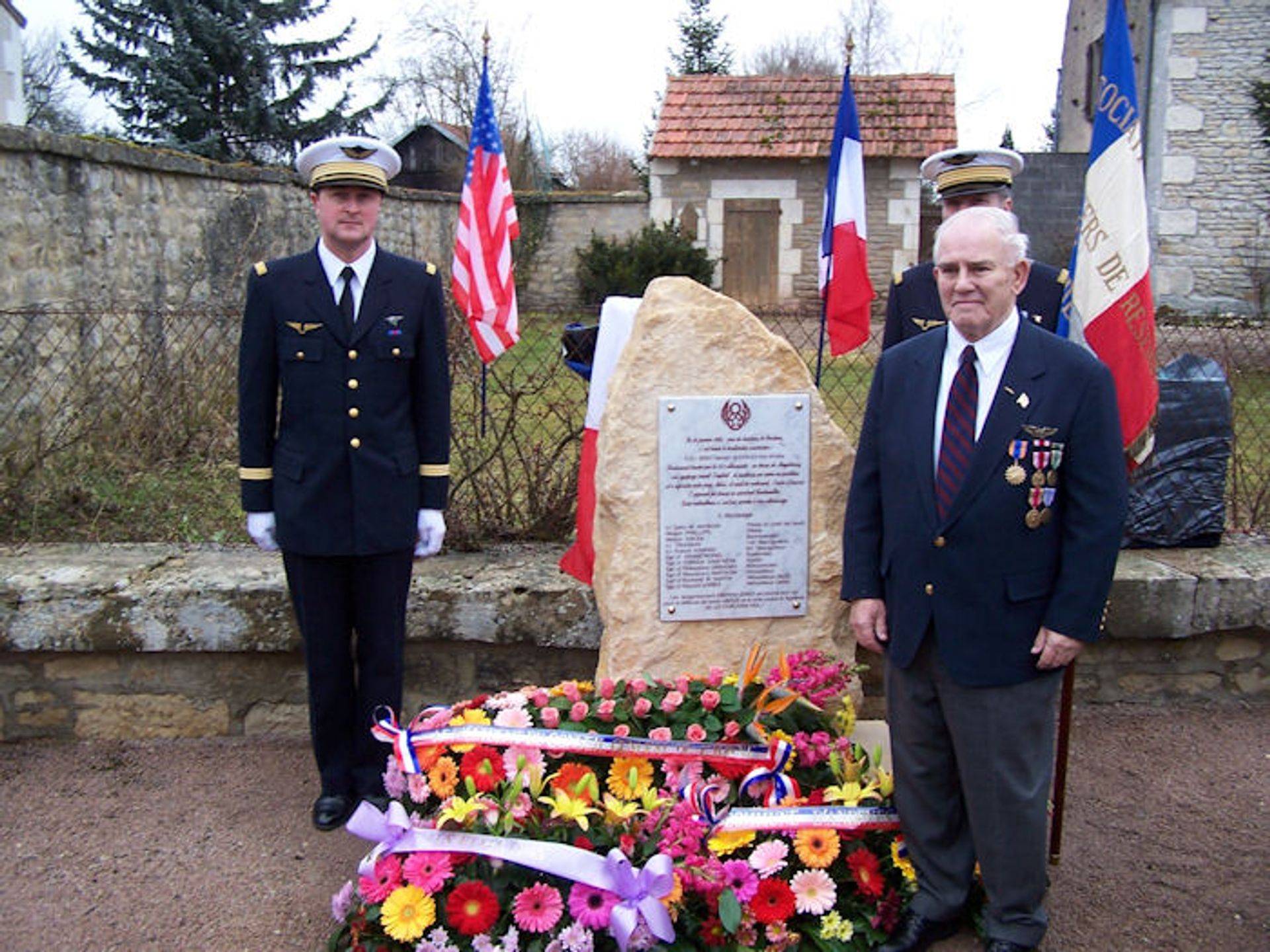Moran Crew – Assigned 752nd Squadron – August 9, 1944
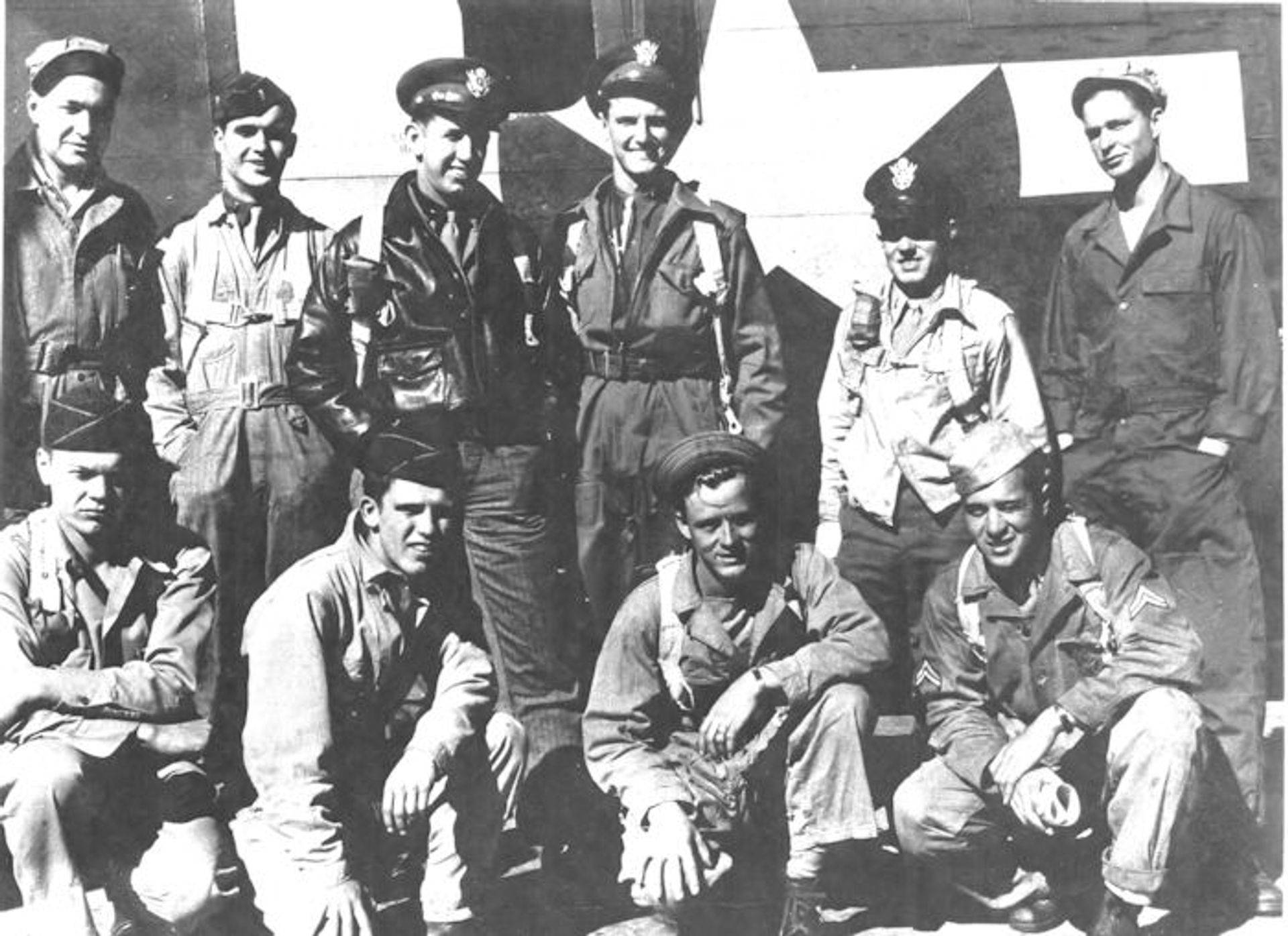
(Photo: Lee Watson)
Shot down January 16, 1945 (Returned To Duty January 21, 1945)
| Rank | Name | Serial # | Pos | Date | Status | Comments |
|---|---|---|---|---|---|---|
| Capt | John W Moran | 0704369 | Pilot | 18-May-45 | FEH | Transferred to 752nd Sqdn |
| Capt | Robert W Shaw | 01016477 | Co-pilot | 17-May-45 | FEH | Transferred to 755th Sqdn |
| 1Lt | Frank E Adams | 02000258 | Navigator | 17-May-45 | FEH | Transferred to 753rd Sqdn |
| 1Lt | Howard A Bradley | 0708064 | Bombardier | 29-May-45 | FEH | TD to London |
| T/Sgt | Clifford W VanNess | 37429753 | Radio Operator | 03-Apr-45 | FEH | Promoted to T/Sgt |
| T/Sgt | Theodore W Urbano | 32891727 | Flight Engineer | 17-May-45 | FEH | Transferred to 752nd Sqdn |
| S/Sgt | Harold N Jones | 38435950 | Aerial Gunner | 16-Jan-45 | KIA | Denton County, TX |
| S/Sgt | Richard B Smith | 34582959 | Aerial Gunner | 16-Jan-45 | KIA | St. Clair County, AL |
| S/Sgt | David J Stodder | 16135978 | Aerial Gunner | Apr-45 | CT | Trsf to 70RD for return to ZI |
| S/Sgt | Maurice L Watson | 33734040 | Aerial Gunner | 17-May-45 | FEH | Transferred to 752nd Sqdn |
2Lt John Moran’s crew came to Horsham towards the end of summer 1944. They were at first assigned to the 752nd Squadron flying their first mission on August 26th. The crew’s third mission on September 11th was filled with mechanical difficulties and they had a rough go of it back to Horsham, but they made it (see diary entry below).
The 458th came off of Operational missions on September 12th, and began hauling gasoline to Patto’s Army in France. Moran participated in 7 of these “Truckin'” missions before the beginning of October. On October 23rd the crew was transferred to the 755th Squadron to be a lead crew. They flew lead on 19 of their 21 remaining missions. Undoubtedly their biggest trial by fire came on the crew’s 16th mission to Magdeburg on January 16, 1945. Robert Shaw, co-pilot; Howard Bradley, bombardier; and David Stodder, nose gunner, did not fly. Major David H. Philip (753rd Sq) was Command Pilot, Major Fred Vacek (Group Bombardier) flew in that capacity, F/O Alden L. Armstrong flew as pilotage navigator, and Lt Harry Fraysier flew as Radar (Mickey) Navigator. [It had been previously recorded on this page that a Lt. Traskin flew as Mickey Navigator, but no trace of him can be found in 458th records. The crew’s load list for this date shows that the Mickey Navigator was Lt Harry Fraysier]
GROUP RECORDS
“On 16th January [1945], on the mission to Magdeburg, Germany, Lt. Moran was flying the Deputy Lead position of the group. As they were approaching the target, the formation was being tracked by several flak batteries. As they flew within range of a four gun battery, the first salvo thrown up burst just in front of the lead ship. The second burst broke just in front of Lt. Moran’s ship. The third burst hit Lt. Moran’s ship between the #3 and #4 engine on the right wing. The impact started a fire in #3 engine and tore away the wing cell. The flak fragments entered the bottom of the engine nacelle and passed diagonally through the wing to emerge from the top of the engine. Flames trailed out behind the wing and past the tail of the ship. The flames burned the fabric of lower half of the right rudder, melted the de-icer boots from the stabilizers and warped the flaps. The turbo on the #4 engine was knocked off. The control cables of the #3 throttles, mixture and feathering mechanism were cut. This made it impossible to feather #3 prop and it continued to windmill at 2300 RPM’s. Part of the left aileron was cast away and there was only 14 inches of power on #4 engine. Lt. Moran stayed with the formation to drop his bombs and then dropped off to the left of the formation and started back on a SW heading to try and get back to friendly territory. The fire in #3 engine burned itself out after 4 minutes after the engineer had shut off the gas lines leading to the engine. The flak fragments had also entered the side of the plane and knocked out the Mickey set inverters, thus making the PFF equipment useless. The weather was 9/10th undercast making navigation extremely difficult.
“Lt Moran instructed the Command Pilot [Major Philip] to contact the escort for protection as they had a long way to go with only two smoothly operating engines. The inter-phone had gone out and difficulty was encountered when Lt. Moran tried to inform the crew of the condition of the plane and what he was attempting to do. He instructed them that he was attempting to reach friendly territory before landing or giving the bail out order. A heading of southwest was held although no one was sure of their exact location. After 2 hours of flying this course, Lt. Moran intercepted the returning “bomber stream”. Major Philips, the Command Pilot, contacted the wing leader on VHF. About this time the navigator gave Lt. Moran a heading of 252 degrees that would lead them to an emergency landing strip in Allied possession. Two minutes before running out of gas, Lt. Moran had gotten the ETA of reaching friendly territory as 10 minutes. Lt. Moran was flying at 11,000 feet when he ran out of gas so he feathered #1, #2, and #4 engines. He figured that he might be able to glide the remaining distance as his rate of decent was 1500 feet per minute and he was at 11,000 feet. He gave the order to stand by to bail out and sent the engineer back to the waist to instruct the gunners to be ready to bail when he gave the order. When the altimeter showed that he had descended to 3000 feet and they had entered the undercast, the order to abandon ship was given. Lt. Moran was the last man to leave the ship at 1445 hours at 1500 feet. His chute opened when he was 300 feet from the ground and he made a safe landing.
“The FFI picked up most of the crew almost immediately. The Mickey Navigator [Lt Fraysier] was wandering around until the next day. Lt. Moran walked in a westerly direction for about 4 hours when he came to a small rural community where he saw a farmer alone working in his barn. He walked up and asked the farmer where he was and the farmer showed him on a map where his place was located. The farmer called the French Police and the police in turn called the FFI and they came out and took Lt. Moran back to the place where his crew was waiting. The crew was taken to the nearest United States military police detachment that was about 40 kilometers away.”
Two of the gunners on this crew S/Sgt Richard Smith and S/Sgt Harold Jones were killed when their parachutes, presumably frozen by the cold temperatures at altitude, failed to open. The crew was back at Horsham St. Faith on January 21, 1945.
The crew was sent on leave and flew their next mission almost one month later, on February 15th to – Magdeburg! The crew’s last mission, number 27 was on April 15th to the Royan Area. On this date, the 458th used Napalm for the first time. The 8th Air Force flew its final mission of the war ten days later. 2Lt Robert Shaw flew two missions as first pilot in April 1945. On his first attempt on April 15th, their ship is listed as “NO TAKE OFF”, but the reason for this is unknown. On the April 18th mission to Passau, Germany, Shaw flew as Group Deputy Lead.
Missions – John Moran as Pilot
| Date | Target | 458th Msn | Pilot Msn | Cmd Pilot | Ld | Serial | RCL | Sqdn | A/C Msn | A/C Name | Comments |
|---|---|---|---|---|---|---|---|---|---|---|---|
| 26-Aug-44 | DULMEN | 120 | 1 | 42-109812 | V | 7V | 41 | UNKNOWN 016 | |||
| 27-Aug-44 | FINOW | 121 | 2 | 41-29352 | K | 7V | 51 | WOLVE'S LAIR | MISSION CREDIT IN NOV | ||
| 01-Sep-44 | PFAFFENHOFFEN | ABN | -- | 44-40118 | R | 7V | -- | WE'LL GET BY | ABANDONED | ||
| 11-Sep-44 | MAGDEBURG | 126 | 3 | 41-29305 | N | Z5 | 38 | I'LL BE BACK/HYPOCHONDRIAC | |||
| 20-Sep-44 | HSF to CLASTRES | TR04 | -- | 42-100311 | P | 7V | T3 | YOKUM BOY | CARGO | ||
| 22-Sep-44 | HSF to CLASTRES | TR06 | -- | 42-100311 | P | 7V | T4 | YOKUM BOY | CARGO | ||
| 25-Sep-44 | HSF to LILLE | TR08-1 | -- | 42-7562 | C | 445BG | T1 | BETTY | 1ST FLIGHT | ||
| 25-Sep-44 | HSF to LILLE | TR08-2 | -- | 42-7562 | C | 445BG | T2 | BETTY | 2ND FLIGHT | ||
| 28-Sep-44 | HSF to LILLE | TR11 | -- | 42-50335 | A+ | 389BG | T6 | NO NAME OR NAME UNKNOWN | 1ST FLIGHT | ||
| 28-Sep-44 | HSF to LILLE | TR11 | -- | 42-50335 | A+ | 389BG | T7 | NO NAME OR NAME UNKNOWN | 2ND FLIGHT | ||
| 29-Sep-44 | HSF to LILLE | TR12 | -- | 42-100177 | L | 44BG | T6 | NO NAME or NAME UNKNOWN | TRUCKIN' MISSION | ||
| 06-Oct-44 | WENZENDORF | 129 | 4 | 42-50502 | A | 7V | 7 | LARRUPIN' LINDA | |||
| 12-Oct-44 | OSNABRUCK | 132 | 5 | 42-50504 | D | 7V | 6 | UNKNOWN 019 | |||
| 14-Oct-44 | COLOGNE | 133 | 6 | 44-10487 | B | 7V | 11 | Girl on surfboard (no name) | |||
| 22-Oct-44 | HAMM M/Y | 137 | 7 | 42-50504 | D | J3 | 9 | UNKNOWN 019 | |||
| 06-Nov-44 | MINDEN | 143 | 8 | QUINN | L2 | 42-50502 | G | J3 | 14 | LARRUPIN' LINDA | |
| 09-Nov-44 | METZ AREA | 145 | 9 | 42-50608 | W | J3 | 7 | FILTHY McNAUGHTY | POSSIBLE ANA | ||
| 16-Nov-44 | ESCHWEILER | 147 | 10 | BREEDING | L | 42-50768 | Y | J3 | 17 | ARISE MY LOVE AND COME WITH ME | |
| 10-Dec-44 | BINGEN | 154 | 11 | 42-50740 | Q | J3 | 10 | OUR BURMA | |||
| 18-Dec-44 | KOBLENZ | REC | -- | WAGNER | L3 | 42-51939 | G | J3 | -- | UNKNOWN 028 | RECALL DUTCH ISLE |
| 28-Dec-44 | ST. WENDEL | 160 | 12 | BREEDING | L3 | 42-51743 | F | J3 | 4 | UNKNOWN 006 | |
| 01-Jan-45 | KOBLENZ | 163 | 13 | QUINN | L3 | 42-95557 | H | J3 | 17 | LADY PEACE | |
| 08-Jan-45 | STADTKYLL | 167 | 14 | BETZOLD | L2 | 42-51669 | J | J3 | 1 | UNKNOWN 026 | |
| 16-Jan-45 | MAGDEBURG | 171 | 15 | PHILLIP | D1 | 42-50954 | A | J3 | 12 | UNKNOWN 021 | BAIL OUT FRANCE - 2KIA |
| 15-Feb-45 | MAGDEBURG | 182 | 16 | PHILLIP | L4 | 42-50740 | Q | J3 | 22 | OUR BURMA | |
| 16-Feb-45 | OSNABRUCK | 183 | 17 | L3 | 42-95557 | H | J3 | 22 | LADY PEACE | ||
| 21-Feb-45 | NUREMBERG | 185 | MSHL | -- | -- | -- | -- | MARSHALING CHIEF | |||
| 22-Feb-45 | PEINE-HILDESHEIM | 186 | 18 | BOOTH | L | 42-51669 | J | J3 | 8 | UNKNOWN 026 | |
| 25-Feb-45 | SCHWABISCH-HALL | 189 | MSHL | -- | -- | -- | -- | MARSHALING CHIEF | |||
| 28-Feb-45 | BIELEFELD | 192 | MSHL | -- | -- | -- | -- | MARSHALING CHIEF | |||
| 02-Mar-45 | MAGDEBURG | 194 | 19 | QUINN | L2 | 44-48837 | L | J3 | 14 | UNKNOWN 041 | |
| 14-Mar-45 | HOLZWICKEDE | 203 | 20 | BLACK | D1 | 42-51669 | J | J3 | 17 | UNKNOWN 026 | |
| 17-Mar-45 | HANNOVER | 205 | 21 | HENSLER | D1 | 42-51669 | J | J3 | 19 | UNKNOWN 026 | |
| 20-Mar-45 | HEMINGSTEDT | 208 | 22 | BETZOLD | D1 | 42-51743 | F | J3 | 25 | UNKNOWN 006 | SHIP 628 - GAS LEAK |
| 23-Mar-45 | OSNABRUCK | 211 | 23 | BRECKENRIDGE | D1 | 42-51669 | J | J3 | 22 | UNKNOWN 026 | |
| 24-Mar-45 | KIRKOFF | 213 | 24 | WOODWARD | L3 | 44-49910 | D | J3 | 5 | UNKNOWN 044 | |
| 05-Apr-45 | PLAUEN | 218 | 25 | GARDNER | L1 | 42-95557 | H | J3 | 45 | LADY PEACE | |
| 11-Apr-45 | REGENSBURG | 224 | 26 | LaVELLE | D1 | 42-51936 | I | J3 | 31 | UNKNOWN 027 | |
| 15-Apr-45 | ROYAN AREA | 226 | 27 | MEYERS | L2 | 44-50693 | P | J3 | 3 | UNKNOWN 054 |
Capt John Moran
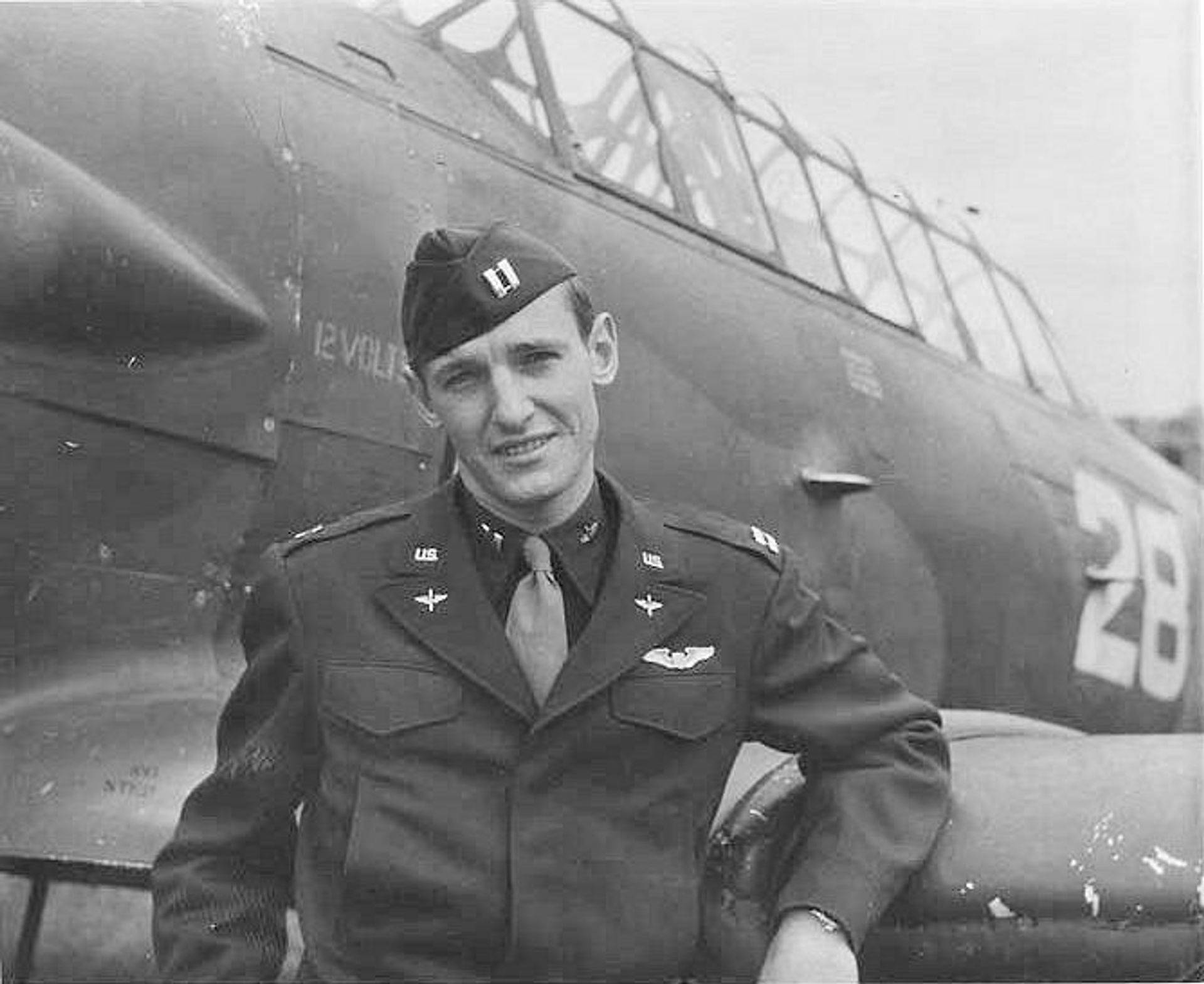
In front of an AT6 trainer aircraft in an undated photo.
Missions – Robert Shaw as Pilot
| Date | Target | 458th Msn | Pilot Msn | Serial | RCL | Sqdn | A/C Msn | A/C Name | Comments |
|---|---|---|---|---|---|---|---|---|---|
| 15-Apr-45 | ROYAN AREA | 226 | NTO | 42-95557 | H | J3 | -- | LADY PEACE | NO TAKE OFF |
| 18-Apr-45 | PASSAU | 228 | 1 | 44-50892 | N | J3 | 5 | UNKNOWN 055 | DEP LEAD - WOODWARD Cmd P |
Sgt Maurice Lee Watson – Diary
MISSION #1
DATE: August 26, 1944 (Saturday)
SHIP: 812-V
TARGET: Dulmen, Germany (Oil Dumps)
GAS LOAD: 2500 Gallons
BOMB LOAD: 4800 lbs. TYPE: 100 lb. G.P
TIME: 0515 hours
We were awakened at 0334, ate and were briefed at 0430. All of us were rather excited due to the fact that this was our first mission. We found our target to be in Dulmen, Germany and was camouflaged in woods. We were assigned to fly high-right element, were shown the usual pictures, blessed by the Chaplain and then were dismissed to dress and go to our ships. We all drew our new heated clothing and went out to our ships via trucks. After a 2-hour delay, we took off at 0930, formed and left the coast at 1045 gaining altitude. We put on our masks and got ready. We in the waist had our flak-suits on, and I had a helluva lot of trouble with mine and almost passed out. Much to my surprise, we saw no fighters except our P-47’s, P-51’s, and P-38’s, and also no flak. We in the waist threw out chaff all the time over enemy territory. We hit our target OK, turned back for home and landed at 1530.

MISSION #2
DATE: August 27, 1944 (Sunday)
SHIP: 352-K (Wolves Lair)
TARGET: Finow, Germany (Jet Air-Field)
G.L. 2700 Gallons
B.L. 5250 lbs. TYPE: 250# G.P.
TIME: 0526 hours
We slept late, ’til 0650, were told to eat and be at a briefing at 0815. We were shown the target and really booed, as it was deep in Germany, which isn’t good. It was a Jet Air Field, which meant many fighters. It was just 25 miles north of Berlin. I was a little shaky as we left the room to go to our ship and pre-flight. We took off at 1115, formed and left the coast at 1225. We were going over water for many miles as we were to pass over Denmark. Our formation settled to a good one and all was well until we were just over the enemy coast, when we found out that the target was “weathered” in. I saw some thick flak up ahead, so it didn’t matter much. We fooled around for a few minutes and then aborted. Back to England we came with the bomb load and landed at 1700 hours. I was a little disgusted and very tired. [Crews received credit for this mission in November 1944]
MISSION #A
DATE: September 1, 1944 (Friday)
SHIP: 118-R
TARGET: Pfaffenhoffen (Ammo Dump)
G.L. 2700 lbs.
B.L. 5000 lbs. TYPE: 1000# G.P.
TIME: 0600 hours
We were awakened at 0335, were told to eat at 0430 and go to briefing at 0500. When we found out what our target was and that there was no flak, we more or less cheered. We then were given total absolution by Father Galleger and went out to our ships. We pre-flighted as usual and were to take off at 0730 hours. About 0715 hours, a B-24 P.F.F. ship [Command Pilot Capt. Leland Griffith, 753BS] from the 466th crashed and exploded about 500 yards from us. We were off at 0740 and everything was well. We found we had an oil leak in #3, so we landed, had it patched and were off again. We found our formation and at 1000 hrs. saw London for the first time, after which we left the coast at 1015. We saw all of liberated France with all of its crater holes. When, after seeing much of France, were told to abort due to weather again. We did so and landed 1350. Another “Letter” mission, dammit.
Intelligence Reports – Ammo dump is the target for our 34 A/C, but aborted due to poor weather at a point west of Paris and northeast of Chartres. No sortie.
MISSION #B
DATE: September 6, 1944 (Wednesday)
SHIP: 709-T (Lucky Strike) (W W today)
TARGET: Hanover, Germany (Oil Dump)
G.L. 2500 Gallons
B.L. 5250 lbs. TYPE: 250# G.P.
TIME: 00:00 HOURS
SCRUBBED
Were alerted at 1700 on the 5th and were awakened at 0330, were told to eat and be at briefing at 0445. At briefing, were told that Hanover’s Oil Dump was to be our target. Our ship number and position as low left were read out. We were to see no fighters, but flak was heavy, and when they tell you heavy – they really mean it. We were to pick up P-51 ‘s going and coming with P-38’s over the target. The rest of the heavies were going in with us on the same route so the Hun would be waiting for us. We were to bomb at 23,000 ft. Father Galleger gave us communion and we dressed and went to our ships to pre-flight. We were ready for T.O., which was 0715 hours, when the raid was set back to 1030. We came back to the barracks and later were told that it was scrubbed because of weather.
MISSION #C
DATE: September 7, 1944 (Thursday)
SCRUBBED
We were alerted at 1700 on the 6th and thought we were going back to Hanover. We got to bed early expecting an early call, but it was a “stand-down” until 1000 hours and later it was “scrubbed” because of weather.

MISSION #3
DATE: September 11, 1944 (Monday)
SHIP: 305-N (I’ll Be Back)
TARGET: Magdeburg, Germany (oil refinery, gas storage)
G.L. 2700 gallons
B.L. 5000 lbs. TYPE: 100# G.P.
TIME: 0600 hours
This morning, were awakened at 0400, were told to eat and be at briefing at 0530. There we found out our target to be Magdeburg’s Oil Refinery with our wing’s objective as a gasoline storage. We were to go in via Coblenz, where no flak was to be encountered, and then hit our target with flak 4 minutes before and 2 after. Here I pulled pins and got ready for the crossing of the Siegfried Line at 1110. We had been rushed since T.O., so there was little time to put on our masks, flak suit, and as we were at 15,000, it was a little difficult. Here we started climbing to 23,000 for our I.P. Our course brought us over Coblenz where no flak was reported. Well, we really hit it, accurate and intense. At this time, #4 was leaking oil, #2 and 4 were smoking, along with a gas leak in #3. About 20 minutes before our I.P., I reported #1 smoking badly. We were 8 minutes late at our I.P. which we hit at 1218, with #1 still smoking. No’s. 2, 3, and 4 giving us the same trouble also. At 1220, #1 was noticed as not pulling but 10 inches of mercury. We were to fly wing, high right in ship 305-N. Father Galleger gave us Holy Communion, after which we dressed and went to our ship.
Standby was 0645 with T.O. at 0715. The latter was set back to 0800 hours. Here is where our trouble began. We pre-flighted all of our equipment as usual and were ready to “marshal” when the Crew Chief found #3’s starter no good.
He fooled around with it and had to spend 20 minutes before it was okay. Then #2’s Prop Governor was no good, so that was replaced. It was now 0900. We took off at 0905, an hour late. We had little trouble finding our formation, and left the coast at 7,000 ft. around 0935, hitting the French coast at 10,000. Here I pulled pins and got ready for the crossing of the Siegfried Line at 1110. We had been rushed since T.O., so there was little time to put on our masks, flak suit, and as we were at 15,000, it was a little difficult. Here we started climbing to 23,000 for our I.P. Our course brought us over Coblenz where no flak was reported. Well, we really hit it, accurate and intense. At this time, #4 was leaking oil, #2 and 4 were smoking, along with a gas leak in #3. About 20 minutes before our I.P., I reported #1 smoking badly. We were 8 minutes late at our I.P. which we hit at 1218, with #1 still smoking. No’s. 2, 3, and 4 giving us the same trouble also. At 1220, #1 was noticed as not pulling but 10 inches of mercury. Our bomb-bay doors were open so it was now or never. At this time, our lead ship [Lt Thomas Horgan] was hit by flak and forced to fall out of formation. It went off to the left, salvoing its bombs with all engines smoking. We saw four chutes go out. We took over lead and the flak really started coming, just as at Coblenz. We had “Bombs-Away” at 1229, and at 1230, we lost #1 engine, then leaving the formation at 23,000 ft.
Lt. Moran told Lt. Adams we were going in by ourselves. We were still having engine trouble. He set us on course while Lt. Shaw asked for fighter escort. In 5 minutes we had about ten P-47’s with us. They were really welcome as we were passing over Hanover, where we saw the smoke of the 1st Bomb. Div. at 20,000 ft. and also “Bandits” were encountered here by the 1st Bomb. Div. We were headed home with the same old engine trouble, the fighters always with us. Urbano was transferring fuel all the time as we were getting low as we passed over the Zuider Zee at 18,000 ft. Here our electrical system was lost, temporary lost, and it got colder. When it came back, Lt. Moran told us to stand by for “Ditching” and I became a little rattled. All of us were ready for it. I was praying a great deal all the way. I had gone to Mass and Communion Sunday, along with Communion this morning, so I wasn’t afraid to go, but I do like to live. We kept creeping along and finally we saw the English coast. My, it was pretty. Lt. Moran told us to stand by to bail out at any time. #2 was only pulling 15″ at this time. We hit Splasher 5 and some airfield. VanNess gave them a few yellow flares and we hit the runway, almost empty. It was 1505. What a day. Our hydraulic system was punctured by one flak burst.
Intelligence Reports – Synthetic oil, 25 A/C by PFF. Ship #314, 752nd Sqdn. hit by flak over Coblenz. Feathered an engine and dropped out of formation. Seven chutes seen, one of which may not have opened, A/C continued flying at 10,000 feet for 10-20 minutes above the undercast, and was in no apparent trouble when last seen.
“Truckin‘” Fuel for General Patton – Operational missions suspended, A/C stripped down to bare essentials of crew and equipment and set to “truckin'” gasoline to Patton’s forces in France. Three main airfields were our destinations, Lille, Clastres and St. Dizier. A total of 494 A/C were dispatched in this operation, and six were lost. One crashed on take-off, killing all aboard. One left for St. Dizier and hasn’t been heard from again. Four were damaged and placed in salvage.
MISSION #4
DATE: October 6, 1944 (Friday)
SHIP: 502A
TARGET: Wenzendorf-Stade, Germany (Air Field)
G.L. 2500 gallons
B.L. 6000 lbs. TYPE: Incendiaries (4# Sticks)
DEPUTY LEAD: MR
TIME: 0555 hours
Much to our surprise, we were awakened at 0330 this morning, told to brief at 0430. Here we were told our target to be an airfield at Wenzendorf. We were to carry our first load of incendiary and our first assignment as a lead crew. Our ship was new and we had no trouble taking off at 0800 hours. We formed in lead element and left the coast at 0940 for our long over-water trip to Northern Holland at 1118. We missed our I.P. as we were at 25,400 ft., which is as high as a B-24 can go. Our primary target area was clear. We were on the alert for fighters as they were on the “deck”. Flak was heavy to our right and accurate, but we had no trouble. We hit our secondary target, also an airfield and it was really beautiful. The Huns are catching hell. We turned toward home seeing 30 boats on the coast, that being the last sight of the enemy. We hit the coast of England at 1335, let down and landed at 1400. An easy one!!
Intelligence Reports – Wenzendorf-Stade airfield hit visually by 27 A/C, fair results.
MISSION #5
DATE: October 12, 1944 (Thursday)
SHIP: 504-O
TARGET: Osnabruck, Germany (R.R.)
G.L. 2300 gallons
B.L. 5200 lbs. (brought back) TYPE: 100# G.P.
TIME: 0500 hours
We were awakened at 0500, told to be at briefing at 0545. Here we were told our target to be a Buzz-Bomb Airfield 25 miles SW of Bremen. As a P.F.F. were given Osnabruck. Flak was 2-3/4 minutes before and 1-1/2 after. I didn’t like it at all.
After briefing, I dressed and was out to the ship at 0630, as standby was 0800 and take off at 0830. We pre-flighted and were told to go. We formed easily and left the coast at 0910, hitting the enemy coast at 0950. It was 6/10 all the way. We got to the I.P. and flak was meager, but accurate. At halfway to the target, we closed our Bomb-Bay and headed for the P.F.F. target. A 466th ship got hit, blew up and 1 chute came out. Our lead ship had Turbo trouble and fell behind the P.F.F. and couldn’t drop. He made a big mistake by not letting us have the lead. Would have hit many targets, but no soap. We started back, always on the lookout for E/A. Nothing came up but we landed at about 1200 hours. I’m getting leery!
Intelligence Reports – 20 A/C started to marshaling yard, nine bombed by PFF, 11 could not find target and did not drop.
MISSION #6
DATE: October 14, 1944 (Saturday)
SHIP: 487-B [pictured at right]
TARGET: Cologne, Germany (Marshalling Yard)
G.L. 2500 gallons
B.L. 6000 lbs. (2000 lbs. Incendiary)
TIME: 0605 hours
We were awakened this a.m. without notice and were told to go directly to briefing. It was 0730, we missed breakfast and briefing and everything was “SNAFU” from the start. We dressed and went to the ship and pre-flighted. We found out our target to be Cologne with 307 flak guns, 7 minutes of flak. That is all we found out. It was a super maximum effort, and we look off 20 minutes late at 0920.
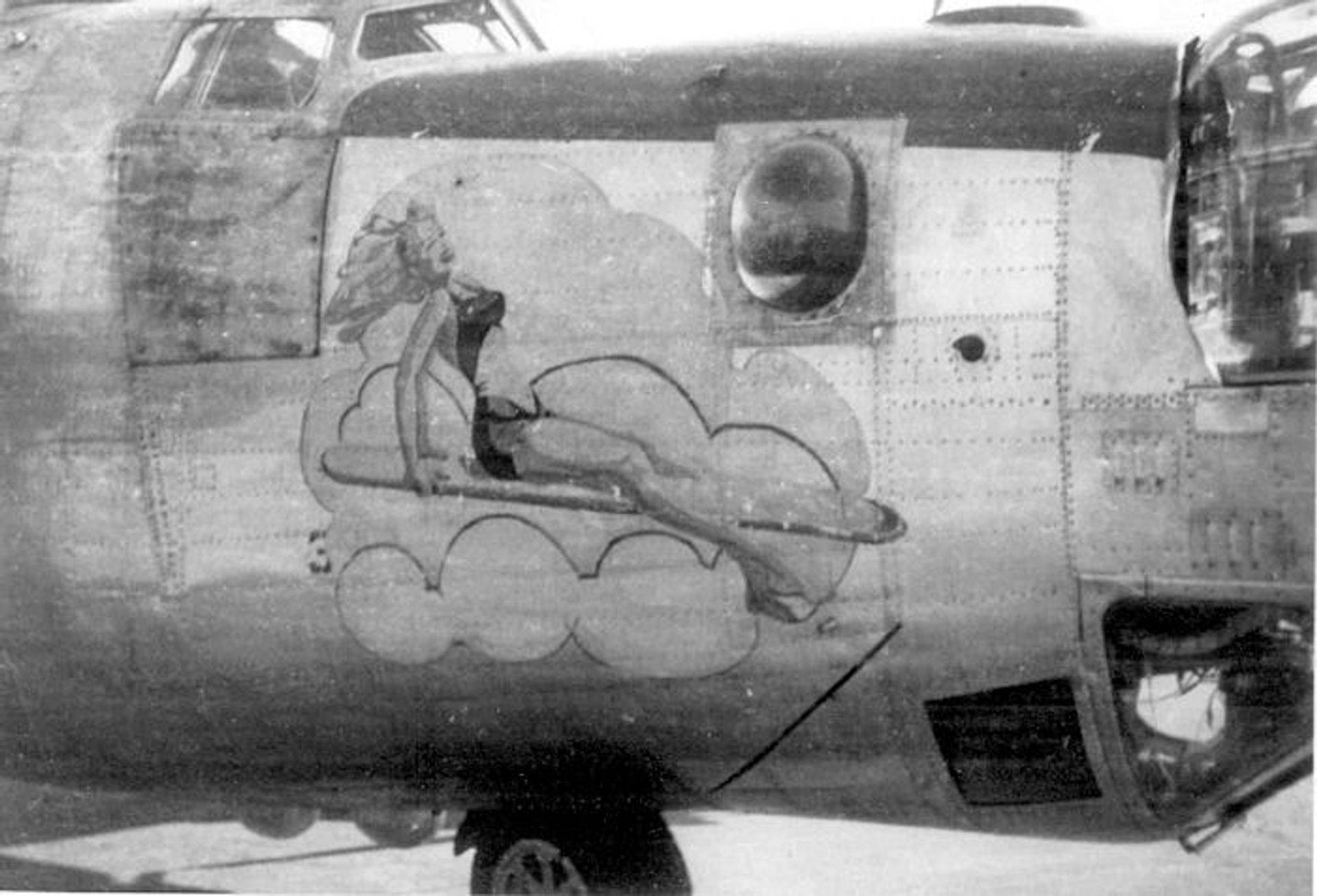
We went directly to 12,000 and left the coast at 1030, not finding our formation until over France. I pulled the pins and put on my chute and flak suit as we hit the I.P. at 1215. Our Bomb-Bay doors were open and I got some good pictures for Lt. Moran. We were the last of 2000 bombers and the first part of the 458th caught hell. We got a few flak holes. One ship was lost, hit by flak [Lt William Klusmeyer]. Flak was accurate and intense, as we dropped our bombs at 1231. We caught flak all the way out. Many ships were full of holes. The 51’s and 47’s were everywhere. It was beautiful. We let down and landed at 1505. I didn’t mind at all. We are supposed to go tomorrow.
Intelligence Reports – 33 A/C by PFF. Ship #864, 755th Sqdn. did not return, hit by flak over Cologne, dropped out with one engine smoking, but it was under control entering broken clouds below, no chutes seen.
MISSION #7
DATE: October 17, 1944 (Tuesday)
SHIP: 487-B
TARGET: Cologne, Germany (Marshaling Yard)
G.L. 2500 gallons
B.L. 6000 lbs. (2000 lbs. Incendiaries)
TIME: 0550 hours
They woke us at 0240 this morning. We ate and went to briefing at 0345. Here we found our target to be a chemical plant 6 miles north of Cologne. Our PFF target was the R.R. yards. Briefing was short, we were all dead tired and chances were it would be PFF. This was supposed to be a rough one. We left, dressed, and pre-flighted.
Take-off was 0615, our first pre-dawn take-off. We formed early at lower left on the 467th. We left England at 14,000; hit the coast of Belgium at 16,000 at 0900. Our I.P. was at 0935 at 24,000. Our bombs went at 0950. Flak was meager and inaccurate for 6 minutes before, 2 minutes after, the target (PFF), and we hit the target through 10/10 clouds. The flak was so inaccurate it surprised all of us. This was an easy mission. It was -39 degrees and it ended well. We came back amid a P-51 “circus”. We landed at 1240 and Cologne has felt our Group.
Intelligence Reports – 33 A/C to marshaling yard, dropped by PFF.
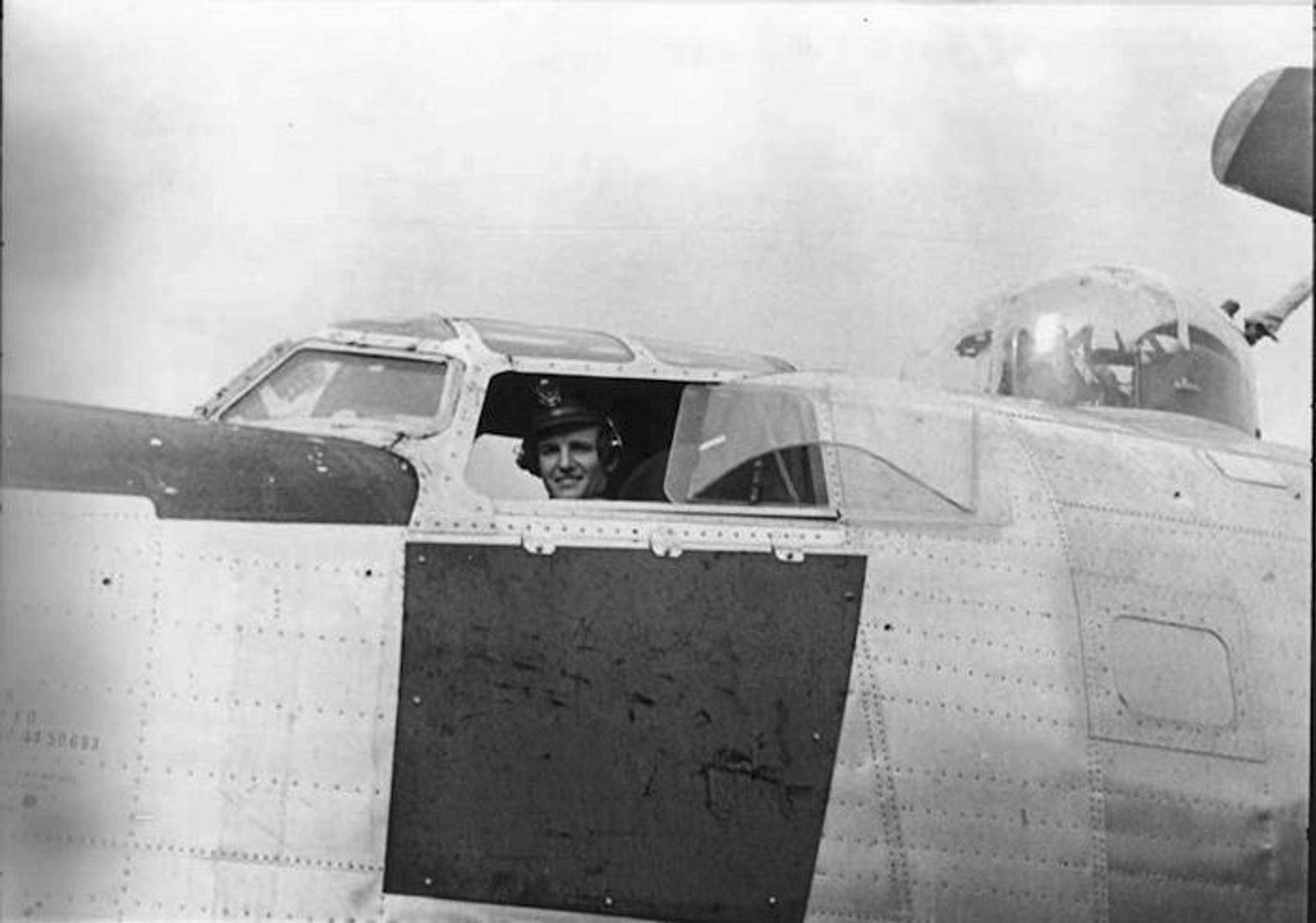
MISSION #8
DATE: October 22, 1944 (Tuesday)
SHIP: 504-D
TARGET: Hamm, Germany (M/Y)
G.L. 2300 gallons
B.L. 6000 lbs. TYPE: 2000 lbs. – 4000 G.P.
TIME: 0550 hours
We were awakened at 0625, ate and were briefed on 0730. I really have one helluva cold and I should have gone on sick-call. We found our target to be Hamm, visual or P.F.F. Stand-by was 1005, take off at 1030, as our ship was marshaled. There were 49 guns at the target, flak 1-3/4 minutes before and 2 minutes after. It was minus 32 degrees at 23,000 ft., our bombing alt. for 4-1/2 hours.
We dressed, pre-flighted and were airborne at 1035. We went to 11,000, formed and left the coast at 1230. We were over the Zuider Zee at 1310 at 21,000 and kept climbing ’til our I.P. at 1425, before which I pulled the pins, put on my flak suit, and out went the chaff. Bombs away at 1440. Flak was very accurate and moderate. No ships went down. My cold gave me hell as we let down and I was glad to see England at 1600. We landed at 1630. No flak holes, no fighters. I don’t mind it so much anymore. Moran [pictured above] is OK.
Intelligence Reports – 23 A/C to marshaling yard, dropped by PFF.
MISSION #9
DATE: November 6, 1944 (Monday)
SHIP: 502-G
TARGET: Minden (Canal Aqueduct Bridge)
G.L. 2300 gallons
B.L. 6000 lbs. TYPE: 2000 G.P.
TIME: 0525 hours
This was to be our first Class “A” lead, 9 to go. We were awakened at 0450, ate and were briefed at 0520. Our target was to be a canal bridge at Minden. It was hit a few days ago and we were to finish it up. There was to be no flak and no fighters. We pre-flighted, took off at 0800, formed easily and left the coast on time at 0941. We had trouble with the C-1 and our air speed indicator was off. We lost our lead squadron for a while and saw accurate flak 20 miles east of the Zuider Zee. We weren’t in any trouble as it was to be PFF at 18,000. We dropped on the 467th and our bombs-away was at 1053 hours. The pattern was good. The P-51’s were excellent cover and everything went off OK. We let down and the temperature was minus 21 degrees Celsius. We landed at 1325 and the mission had poor results due to the failure of both PFF ships.
Intelligence Reports – Minden Canal, 28 A/C bombing by PFF. Observations indicate all traffic blocked from the October attack, but the Germans are working frantically to restore the artery.
MISSION #10
DATE: November 9, 1944 (Thursday)
SHIP: 608-W (Filthy McNaughty)
TARGET: Pillboxes, 6 Miles SE of Metz
G.L. 2300 gallons
B.L. 6000 lbs. TYPE: 2000 G.P.
TIME: 0555 hours
We were awakened at 0300 hours with briefing at 0415. I was really tired and we had too much time. Our target was my first “tactical” mission and a very important one. The entire 8th AF was there. Flak was nil and much to our surprise. Our bombing altitude was 23,000 and it was minus 35 degrees Celsius. Take off was 0650.
We got off good and had to climb to 15,000 feet through solid clouds with ice. We formed with difficulty and left southern England at 0941 climbing. We had plenty of time and our troops were 3 miles from our M.P.I. “Bombs Away” was at 1139, with 3 ships dropping on our troops. One bomb hung up and we had to leave formation due to oxygen failure. Lt. Holmes kicked it out in the channel after much difficulty. We landed with a 50 fool ceiling and poor visibility. It was an easy mission so to speak.
Intelligence Reports – 25 A/C up, 12 hit the target by PFF.
MISSION #D
DATE: November 10, 1944 (Friday)
SHIP: 936
TARGET: Aachen, Germany
G.L. 2300 gallons
B.L. (Checking R.O. Compass Buncher) TYPE: (At Aachen)
TIME: 0425 hours
They got _____ to fly with Capt. Lamers on a secret mission. I didn’t get to briefing and just had time to get out to the ship before take-off. We took off at 1515 and formed over Buncher with a B-17. It looked rather funky. Six P-47’s escorted us to our target. We saw nothing and we ____ our ____ and were on our Bomb Run at 1457 hours. It was 10/10’s and the P.F.F. ship couldn’t raise anything at our target. We started back at dark and our P-47’s left us. We went over Ostend and I got my first search lights. They are really good. We came on down from 18,000 feet and circled, holding before _____. I hope I get credit for this easy one – No flak, no fighters. (No credit).
Intelligence Reports – 28 A/C hit the airfield by PFF.
MISSION #11
DATE: November 16, 1944 (Thursday)
SHIP: 768-Y (Arise My Love & Come With Me)
TARGET: Eschweiler, Germany (Troop Concentration)
G.L. 2500 gallons
B.L. 5200 lbs. Frags
TIME: 0615 hours
We were awakened at 0430 and were briefed at 0510. Our target was to be troop concentrations 10 miles NE of Aachen and the 8th and 9th Air Forces and RAF were to be there. Our altitude was 23,000 with minus 40 degrees Celsius. Moran was to be leading High-high right with Maj. Breeding as Command Pilot. Lt. Shaw wasn’t to go. We had a different route and T.O. wasn’t ’til 1000 with no ceiling and no visibility. We formed easily and opened our Bomb-Bays over the channel as a precaution to our troops. It was G-H and we dropped before the flak came up. Gen. Peck and Col. Isbell were leading and they caught a little. We returned to England to find the base closed in, so we had to land at an English base 86 miles NW of Horsham. We stayed there 3 days and I never want to do it again, as the food was lousy and no place to sleep. We look off from there on the 19th at 1620 and finally got home.
Intelligence Reports – Excellent results from 33 A/C on enemy troops and emplacements. Crews took off in thick fog, bombed their target without injury to any friendly forces, and diverted to Scotland upon returning to base because of the fog. Gen. Doolittle sent a lengthy TWX commending the Group for its extraordinary effort and dedication.
MISSION #12
DATE: December 10, 1944 (Sunday)
SHIP: 740-Q (Our Burma)
TARGET: Bingen, Germany (M/Y)
G.L. 2500 gallons
B.L. 5400 lbs. TYPE: 44-100# G.P., 2-500# Incend.
TIME: 0530 hours
We had been alerted for a week and were glad to know we were “going” when we were awakened at 0430 and briefed at 0445. At briefing, we were told our target to be Bingen, on the Rhine, a M/Y which was important to the 3rd Army. Our secondary was Mainz M/Y, PFF, with 154 guns. Bingen with 12. Minus 44 degrees Celsius at 22,000. We were first over Germany. T.O. at 0745 with ETA at 1319. We got off in time, formed at dawn and left the coast at 0918, reaching our I.P. 1120 after climbing to our bombing altitude. Bomb-Bay doors open and we knew we were to hit our primary target with G.H. “Bombs Away” at 1236 and the best pattern I’ve ever seen. We headed back, and the P-51’s were 2 to 1, and they really were good looking with their contrails at 25,000 feet. We let down after we passed the line, and landed at 1320. Flak over the target was inaccurate and meager. The P-51’s were the stuff.
Intelligence Reports – Good results again, 18 A/C hitting marshaling yard.
MISSION #E
DATE: December 17, 1944 (Sunday)
SHIP: 939-G
TARGET: Coblenz, Germany (Tank Factory)
G.L. 2700 gallons
B.L. 3100 lbs. TYPE: G.P. 500 lbs., 2-50 lb. Smoke Bombs
TIME: 0430 hours
RECALL
We were alerted for a week and finally were awakened at 0500, and were briefed at 0545. We were going to fly lead in High-Right and our target was a Tank Factory by P.F.F. (our first). Flak was to be moderate and no fighters. T.O. was 0915, and at 0920 we’re off. We form and finally leave England at 1050 after much “essing” around. We get off course 15 miles to the North, and are flying at 25,000 when we hit the coast of Holland-Belgium. We went into Belgium 100 miles and were recalled as the B-17’s went in. We let down easily and landed at 1410.
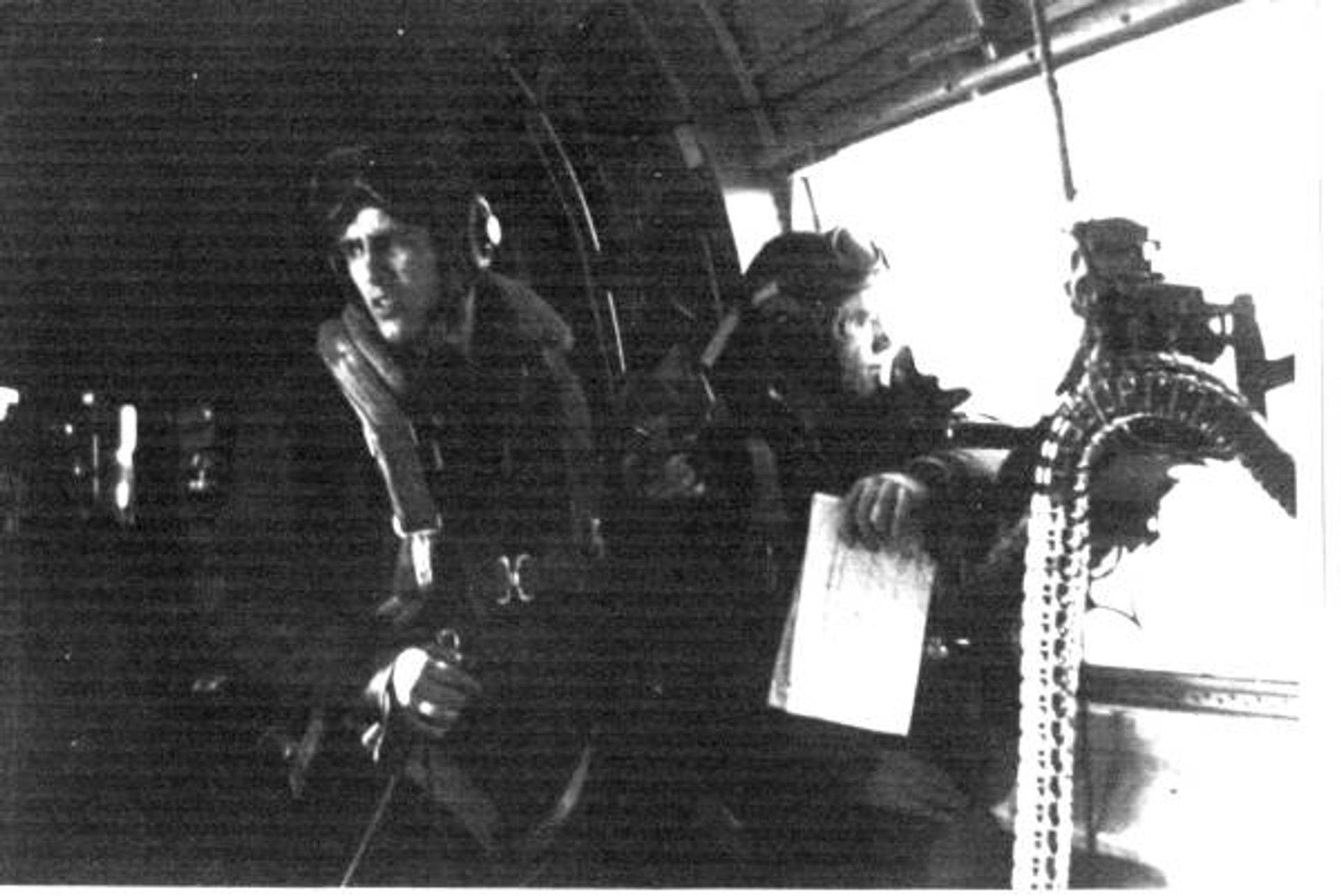
MISSION #13
DATE: December 28, 1944 (Thursday)
SHIP: 743-F
TARGET: St. Wendel, Germany (M/Y)
G.L. 2700 gallons
B.L. 3200 lbs. (Brought Back) TYPE: 6-500 lb. G.P., 2-100 lb. Smoke Bombs
TIME:
Understanding #13, and I had my fingers crossed. They got us up at 0520 and told us to be at briefing at 0625. Here we found our target to be M/Y at St. Wendel. We were to lead the high-right and P.F.F. if need be. There was to be no flak at the target and our P-51’s were to be there in five groups. T.O. at 0915, and return at 1453.
[Lee Watson (left) in the waist position of his B-24]
We got off at 0920, and formed easily. We left the coast at 1040, climbed to 16,000 feet at Ostend at 1121. It was minus 44 degrees Celsius and the mission was going good. We climbed to 25,000 feet and, as we turned on the I.P. G.H. took over, and through malfunction, we didn’t drop because of fear of hitting Allied troops and headed home with Bomb-Bays full. We landed at 1520.
Intelligence Reports – 26 A/C, marshaling yard. Lead A/C had malfunction, all brought bombs back home for fear of hitting Allied troops.
MISSION #14
DATE: January 1, 1945 (Monday)
SHIP: 743-F
TARGET: Coblenz, Germany (RR Bridge)
G.L. 2300 gallons
B.L. 4200 lbs. TYPE: 4-1000 lb. G.P., 2-100 lb. Smoke Bombs
TIME: 0600 hours
We were awakened at 0415 and were briefed at 0545. Here we found our target to be a railroad bridge just east of the city of Coblenz. 52 flak guns were in the vicinity. Our bombing altitude was to be 22,000 feet with -32 degree Celsius at this altitude. We were to go in last and lead the high-right. We were to carry 4-1000 lb. G.P. with two smoke bombs, and it was to be visual. We went to our ship to find that ice was 1/4″ thick on the ship. We tried to be ready for an 0825 take off, but we were late, and got off at _____.
We formed and left the coast climbing. We were OK, until the lead ship went to G-H and after doing three 360 degree turns, we brought our load towards home at 26,000 feet. We lost #1 at Ostend, broke formation, and prepared to ditch due to gas and EF. We kept our altitude and saw England after dropping our bombs in the channel. We came in without a pattern, and landed at 1500 hours – two hours late. We were glad to get in. Tom finished today.
Intelligence Reports – A rough one. Target was bridge over the Moselle at Guls – Coblenz. 27 A/C dispatched, very heavy cloud coverage all the way. Ran into head winds calculated at 180 mph from 40 degrees which reduced our ground speed to 20 mph. Mission abandoned 40 miles from IP. Three A/C bombed with other Groups, remainder returned to base with bombs. Three ships landed on the Continent, short of gas.
MISSION #15
DATE: January 8, 1945 (Monday)
SHIP: 669-J
TARGET: Stadtkyll, Germany
G.L. 2500 gallons
B.L. 3200 lbs. TYPE: 6-500 lb. G.P., 2-100 lb. Smoke Bombs
TIME: 0815 hours
After being alerted for 4 days, we were awakened at 0340, told to be at briefing at 0415, at which time we learned our target was a road junction 3 miles inside Germany behind the Belgian salient, by the name of Stadtkyll. The only picture was very poor, and information even more so. There were to be 12 flak guns at the target. Our route was from London over as the weather was to be bad.
Take off at 0700 hours. Banking out 22,000, and -44 degrees. It was an important target, as they usually don’t send us off to form before dawn. We went to our ship to get it off on its first mission. We had a terrific snow storm before briefing ’til take off. We went to lead the Low Left and got off #10 [in take-off order]. We climbed in the back, formed with great difficulty, and managed to go out on course on time at 0940. Lt. Shaw was flying deputy. As we went into France leading the Division, we had to climb to 25,500 with a temperature of -55 degrees. Contrails were so thick you couldn’t see your wingman. Our target was G-H, and we bombed with much difficulty. On our way out, we lost all but 9 ships of the Group and, after getting back to England, we got lost due to weather, and finally landed at 1520. This was, by all means, my most tiresome mission. Over the hump.
Intelligence Reports – Target, road intersection to interrupt Nazi communications. Instrument bomb run by 14 A/C. Weather really rough, climbed to 24,000 feet to hit I.P. If weather scout had given better summary beforehand, would have abandoned mission. But a good run made, all A/C dropped on time. Returning, 2nd Air Division advised formation to make letdown west of London and come in under clouds to base. Flight was hectic, many ships left formation due to low gas, only five planes made it to base after crossing B-17 landing pattern and coming through snow squalls. All planes landed safely at Yorkshire bases.
MISSION #16
DATE: January 16, 1945 (Tuesday)
SHIP: 954-A
TARGET: Magdeburg, Germany (Krupp Steel Works)
G.L. 2700 gallons
B.L. 3100 lbs. TYPE: 6-500 lb. G.P., 2-100 lb. Smoke Bombs
TIME: 0640 hours
DEPUTY LEAD: Lead Squadron
COMMAND PILOT: Maj. Phillip
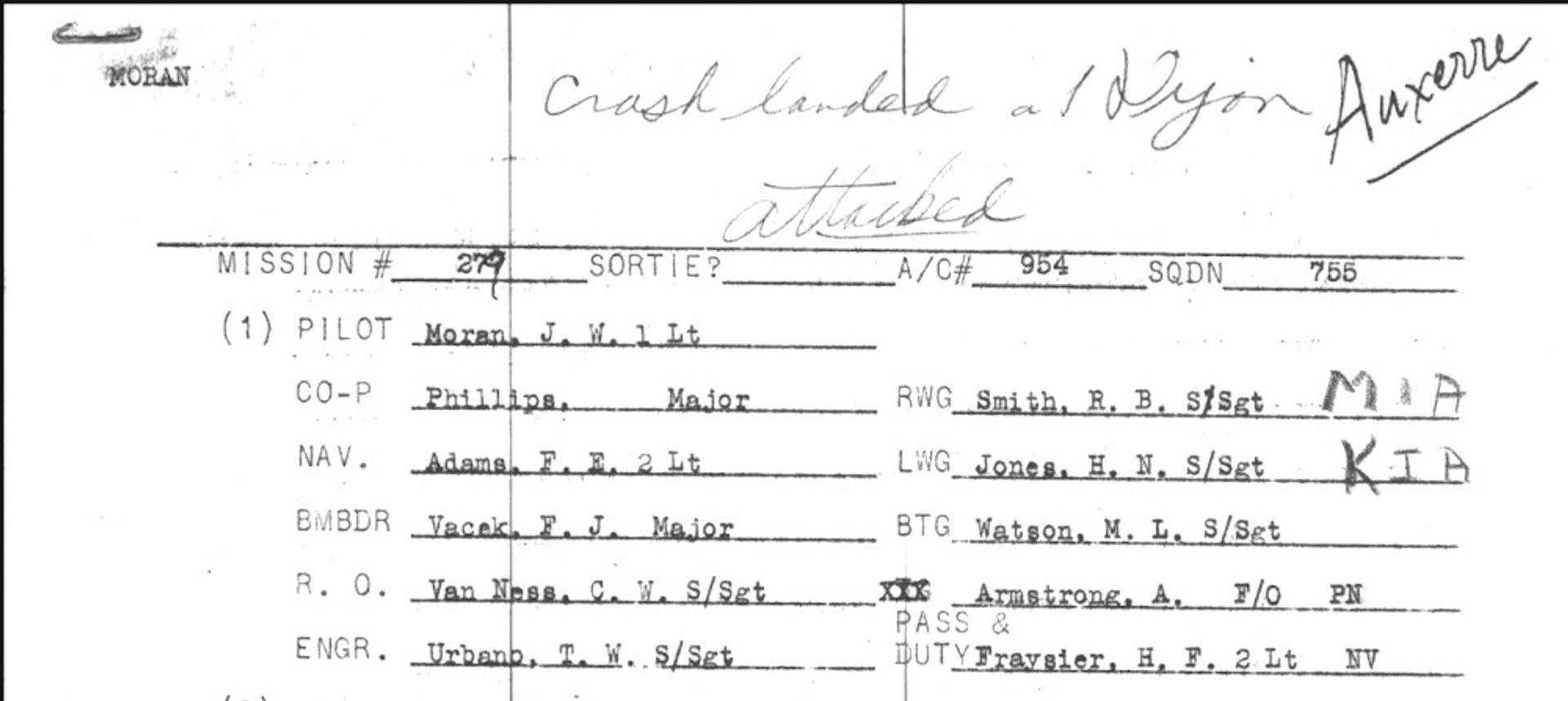
Moran Crew Load List – January 16, 1945
We were awakened early at 0445 and were to be at briefing at 0515. Here we were told our target was to be Berlin or Magdeburg according to the weather. We realized flak would be very rough and everyone was very still. Magdeburg was Plan “A” and we were to bomb the Krupp Tank Factory. There were 74 guns at the target, bombing altitude was 23,000 feet, and temperature was -36 degrees. Berlin had 240 guns and our target was to be industrial sections of the city. Stations were 0740 with T.O. at 0810. We dressed and pre-flighted #954 and were second off at 0803.
We were D.L. on the Lead Ship and forming was no trouble. We headed out on course at 0940, and everything was going fine. We climbed to altitude and as it was 5/10 cloud cover, we kept a course all the way. Before the I.P., we put on our flak suits and I started throwing out chaff as it turned visual. As we hit the bomb run with bomb bay doors open, we were sure it was going to be rough.
One minute before “Bombs Away”, the flak started. It was 155mm and the third burst hit our right wing setting it afire. The fire was 20 feet behind the tail and we were sure it would explode. It hurt the right rudder and melted the flaps. Van and Jones opened the camera hatch, and we put our chutes on. I called Smitty out of the tail turret. We were all ready to go. The inter-phone went out and we didn’t know what was going on up front. Up on the flight deck, Ted saw the fire and quickly shut off the gas. This saved our lives, I’m sure. Lt. Moran or Major Phillip didn’t know of the fire, and only saw that 3 & 4 were no good, pulling 11 & 15″ respectively. In the Bomb-Bay, the flak cut the Mickey and Gee plus the Intercom. Lt. Fraysier and I pulled the “dome” up as we left the formation.
All three navigators were lost as Lt. Adams was in the Bomb-Bay on the bomb run. Flak had put a large hole (12″) in the fuselage by the put-put! No. 3 had a 1″ hole in it. The left aileron had two large holes in it, plus many little holes. We were losing gas and oil by the minute. Jones would have jumped over the target, but a B-24 was under us so he waited. Van, Smitty, and myself would probably have followed. We dropped 5 degree flaps and Lt. Adams steered. On our course out, we threw all the flak suits out to lighten the load, as well as everything of excess weight. Mine went out also. I was hit by a piece of flak which entered over my head. I didn’t say anything to anyone, as it wasn’t necessary.
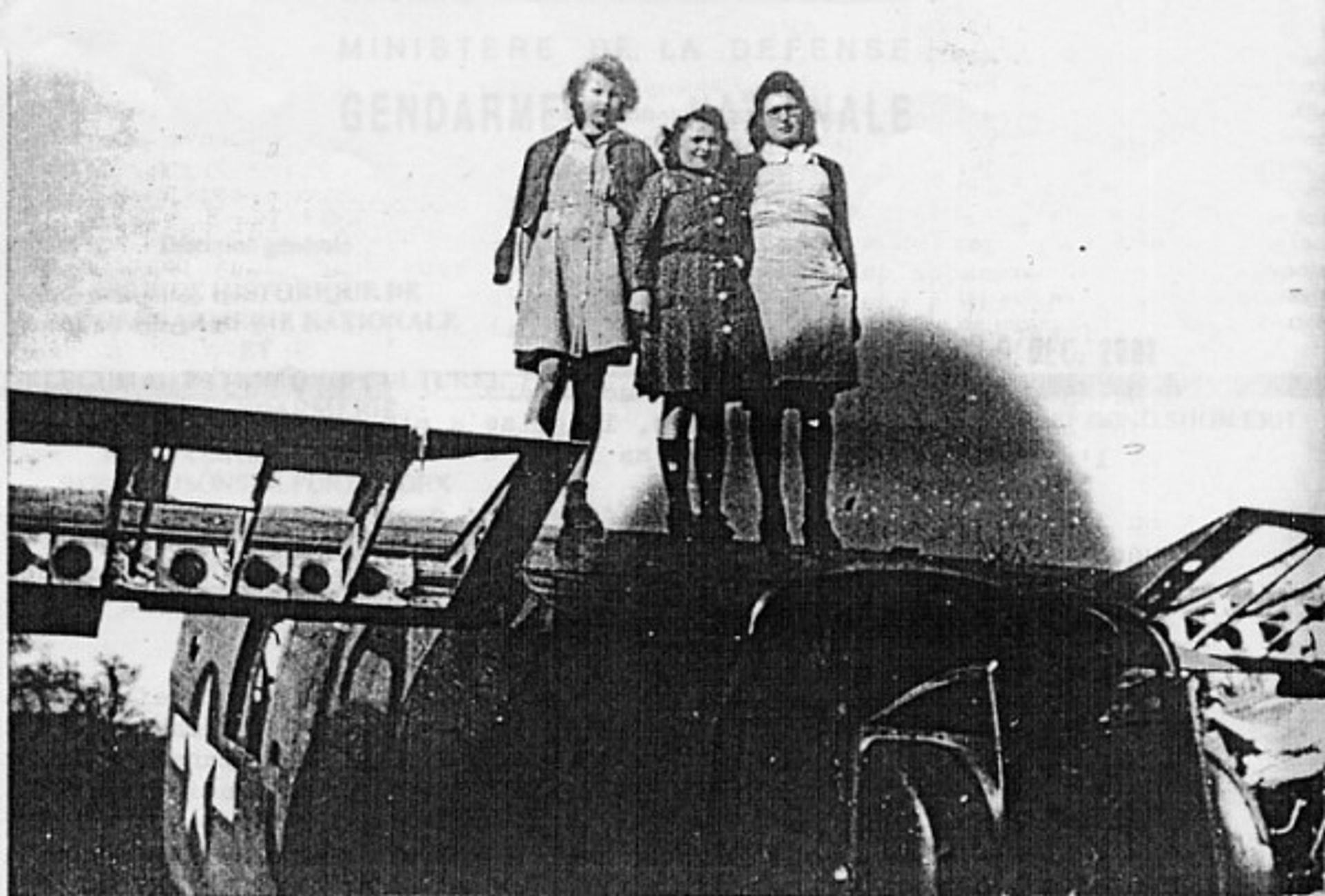
Standing on the wreckage of Moran’s Liberator: Jacqueline Hytier, Huguette Bige`, Ghislaine Bart
(Photo: Jaques Leroux & Jacqueline Hytier)
As we passed over the lines, we saw light flak, but it was 1/2 mile to the left. We were losing altitude while going at 150 MPH. We had just crossed the Rhine when Lt. Moran feathered #1, 2, and 4, as 3 was just wind milling. We were at 10,000 feet, and all of us had plenty of time to fix our chutes, shoes and kits. At 3000 feet, and 1438 hours, we started out. I was very frightened and tried very hard to keep my head. We watched the bomb bay and VanNess lined up at the Camera Hatch with me, Smitty, Ted, and Jones following. Lt. Fraysier left, then Van and Maj. Vacek followed by me, Lt. Adams, Smitty, Maj. Phillip, Ted, F/O Armstrong, Jones and Lt. Moran. The plane was still in live flight and it crashed 8 miles away, breaking in many pieces with the right wing 50 yards from the bulk of the plane.
I left the plane 4th, going out of the camera hatch head first, crawling from the waist position. As soon as the slip-stream hit me, I rolled over on my back and waited a second or more before pulling the rip cord. My chute opened and I received a helluva jolt, biting my tongue. When it opened, I said aloud, “I’m safe, I’m OK” over and over.
I looked up and saw the plane as well as three men coming down. Two chutes opened, but the first didn’t. I watched it hit the woods SW of me and “found” all check points in order that we might find the body. I landed with another jolt, and was stunned for a moment. My tongue was bleeding, and I got my bearings and took my chute off and started down the road, eating some snow on the way. I took off my “Mae West” and lit up a weed. After walking 1/4 mile, I saw Frank Adams. We got together and I gave him my black RAF shoes as his ankle was swelling. A Frenchman took us to Voutailles[?] where Ted and Major Phillip joined us. Here we found Maj. Vacek and Van. We were fed and the F.F.I. questioned us as they thought we were Germans. After much explaining, we convinced them we were USAAF, and wanted to find our crew. F/O Armstrong showed up after this and much talking and explaining lasted for 2 hours.
At 1900 hrs. six M.P.’s from Auxerre, picked us up and took us to Clamecy(?) where we met Lt. Moran, and identified the body of Harold Jones. His head was a mess and we didn’t stay long. We left for Auxerre and arrived at 2200 to a meal and a bed. We went to bed early and sleep came hard. On the 17th, we went to the plane and destroyed all the secret and confidential papers and shot up the GEE Box and other equipment. The plane was a mess, with the right wing and engines 3 & 4 scattered over a 75 yard area. A complete wreck.


French civilians looking over the wreckage
On the 18th, Lt. Fraysier showed up and we went to look for Richard Smith, as he hadn’t showed up. We looked ’til dark and with nothing found, we left, and the FFI, 400 of them, were to do so tomorrow.
On the 19th, we left for Paris at 0830 and after 4 hours in a 6×6 GMC we reached the city. We were assigned to a first class hotel in town, and were given all the liberties of a civilian. We went to the PX and American Red Cross and saw the city.
On the 20th, the ceiling was zero with 6″ of snow, so we again toured the town. Really had one swell time, considering everything.
On the 21st, we took off at 1310 in a C-47 and started for Horsham. My first ride in a C-47 was uneventful and we landed at 3:50 pm. A sad, sorry mission.
KIA – Harold N. Jones, S/Sgt.
KIA – Richard B. Smith, S/Sgt.
Wounded – Frank E. Adams, 2nd Lt.
Intelligence Reports – Visual assist for PFF – results again excellent, target, oil, and the Rothensee refinery. Briefing was, if visual, hit the oil, if not, the Krupp Tank Works at Magdeburg. 27 A/C, crews report hits on the Krupp Works, fires and explosions in marshaling yard as well as on factory with some stringing across a labor camp. Large explosion visible in the marshaling yard, then a few bursts extended to an iron works and armament factory. Another factory, another marshaling yard. Ho, hum.
One A/C hit Guben with 446th Group, crew reports hits on target. One He-111 sighted about 5,000 feet, below formation, no other enemy A/C sighted, moderate flak, tracking variety at Magdeburg, fairly accurate. AA encountered at Wittenberg and meager, accurate flak at the front lines just east of Bischivilles. One crewman killed when chute failed to open over France. From 755th Sqdn. One other crewman missing after parachuting. A/C #954 CRASH-LANDED AT DIJON. FRANCE. EXTENT OF DAMAGE UNKNOWN. One A/C from 467th Group bombed with us, had #3 engine feathered and left formation over France on way home. All A/C diverted until Jan. 17th due to fog. Two crewmen killed when chutes failed to open.
MISSION #17
DATE: February 15, 1945 (Saturday)
SHIP: 740-Q (Our Burma)
TARGET: Magdeburg, Germany (Oil Refinery)
G.L. 2500 gallons
B.L. 6200 lbs. TYPE: 12-500 lb. G.P., 2-100 lb. Smoke Bombs
TIME: 0640 hours
LEAD: 4th Squadron
COMMAND PILOT: Maj. Phillip
We were awakened at 0345, briefed at 0455 and there we saw our target to be Magdeburg. I have never been so scared. I just didn’t know what to do. Magdeburg, again. On top of this, it was to be visual. We had briefing, learned take off was 0750 and we were to lead the 4th Squadron in a new type of formation, again Maj. Phillip was C.P. All of us didn’t like it.
T.O. and assembly and trip were uneventful. Details are not necessary, as I am disgusted. Our I.P. was hit OK, and, as briefed, we got our flak 1-1/2 minutes before bombs away. It was meager and inaccurate. Due to 10/10, I was glad the weather man was wrong. He told “lies” at briefing, and it was OK with me. We did evasive action and didn’t get one flak hole. The trip was slow from target to base, and we saw many B-24’s with feathered engines. We really sweated today. Not only over the target, but all the way. All of us. We let down, as it was CAVU (ceiling and visibility unlimited), and landed from a so called rough mission. I want to go there again.
Intelligence Reports – 36 A/C, still after oil refinery at Magdeburg as it is number 3 on the priority list, and capable of producing 10,000 metric tons a month, which is about 50% of its original output. Results unobserved, solid undercast. Crews feel run was good, but might have dropped a little over. Black smoke was seen billowing into clouds to 10,000 feet as our A/C left for home. No enemy A/C, meager – moderate but inaccurate, barrage type flak at target, 21 – 22,000 feet. No other AA encountered. Canal from Alkmaar to Purmurend filled with barges.
MISSION #18
DATE: February 16, 1945 (Sunday)
SHIP: 557-H
TARGET: Osnabruck, Germany (M/Y)
G.L. 2300 gallons
B.L. 3200 lbs. TYPE: 6-500 lb. G.P., 2-100 lb. Smoke Bombs
TIME: 0550 hours
LEAD: 3rd Squadron
COMMAND PILOT: Lt. Shaw
Flying two days straight for a lead crew is something out of the ordinary. We were very surprised. We slept late, until 0645 and when we arrived at briefing, we saw we were going to Osnabruck. This is a rough target with 79 guns, but as we were almost sure we were going back to Magdeburg, we didn’t mind one bit.
T.O. was at 1120, and everything went off OK. It was -39 degrees at 23,000, and the voltage was low, we were cold the entire trip. Our I.P. came up fast, and I was busy the entire trip. We had to cut out the 2nd Squadron as the leader aborted and they were SNAFU. Flak at the target wasn’t too bad, and I swore I’d quit if I got back, but I guess I’ll go again. The weather was bad all the way, bombing by G.H. with good results. We had to make an instrument let down, and Lt. Moran really did one good job today. We didn’t even know we hit the runway with 1 mile visibility and 200 feet ceiling. Today was cluster day. 12 more to go.
Intelligence Reports – Marshalling yard. 26 A/C, solid undercast, but crews feel this was the best PFF run we’ve ever made. Bombs scattered over the target area in all directions. Moderate, accurate flak at target, no enemy A/C.
MISSION #19
DATE: February 22, 1945 (Thursday)
SHIP: 669-J
TARGET: Hildesheim, Germany (M/Y)
G.L. 2500 gallons
B.L. 3200 lbs. TYPE: 6-500 lb. G.P., 2-100 lb. Smoke Bombs
TIME: 0700 hours
LEAD: 3rd Squadron
COMMAND PILOT: Maj. Booth
We were awakened at 0500 and were briefed at 0545, knowing we were to go at 2000 gals. and 6-500 lbs. Col. O’Neill had to wait 5 minutes after he told us that we were to bomb from 10,000 feet. It was the biggest thing since Ploesti; and he even said to strafe all rolling stock. It was to be a big deal with the 8th, 9th, 12th, 15th AAF, RAF, and others going in to hit M/Y in Central Germany. Our target was to be Hildesheim, a small town with only light flak, but all the way into the target. We formed at 12,000 after a T.O. at 0800, and left on course on time. We climbed to 22,000 over the Zuider Zee, and then started our perilous let down over the Reich. As we reached 10,250 feet, we could see everything plainly, and as we were off course, three B-24’s got direct hits and the boys didn’t have a chance. Bandits were in the area. Gunners were strafing, rolling stock. 88mm’s were very accurate and we were lucky. Navigator salvoed bombs early; therefore, we were Royal SNAFU’d. Other group hits were plainly visible. Bomb Groups 466th, 467th, 481st were the reason for poor results, although the wing report was “Good”. I’ll take 20,000+ for my remaining.
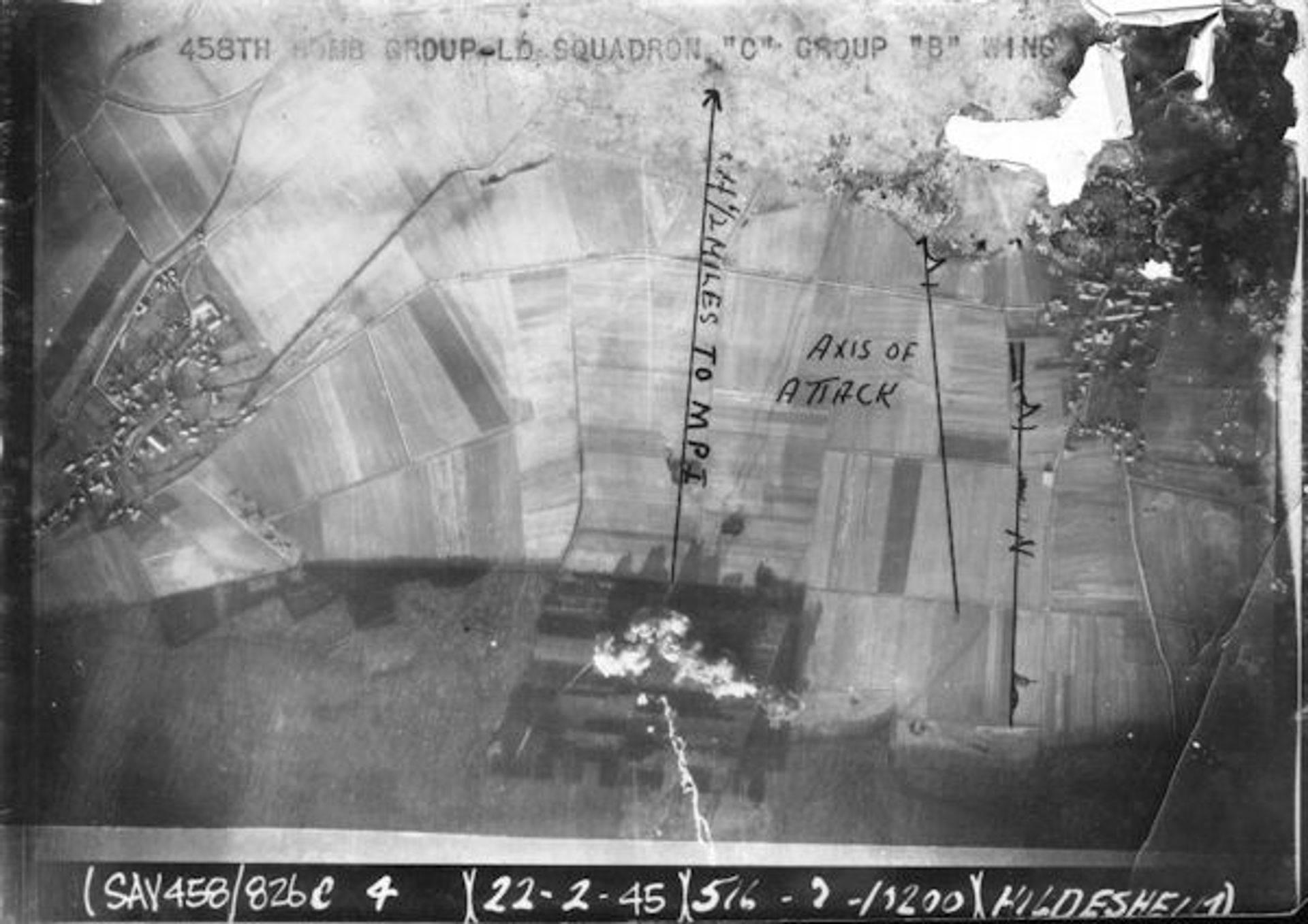
Intelligence Reports – Two pronged attack on two marshalling yards, 38 A/C dispatched, 34 bombed, results called fair as follows: 16 hit Peine visually, good hits in the yard and adjacent factory buildings. 18 went to Hildesheim. One Sqdn. bombed short in woods while all other reported good hits in the yard with large fires.
One dark colored single engine enemy A/C seen attacking another Group near Nortlieim on bomb run. Most crews did not see any enemy A/C. No flak at Peine or Hildesheim. Meager-moderate heavy of the visual, tracking type encountered before bombs away early on the run vicinity of Hersfeld. This was very accurate, and one crew reported railroad guns firing in this area. No AA encountered back from target. One plane definitely, another probably, lost from our Group. #215, 752nd Sqdn. received a direct hit on bomb run near Bebra [Lt Joseph E. Szarko]. The plane disintegrated and was seen to crash. One chute seen. A/C #491, 754th Sqdn. [Lt William A. Duke] peeled off formation between Hersfeld and Bebra. This plane jettisoned bombs. Heavy explosions seen in Eschwege marshaling yard after bombing by another Group, smoke up to 11,000 feet.
MISSION #20
DATE: March 2, 1945 (Friday)
SHIP: 837-L
TARGET: Magdeburg, Germany (Krupp Steel Works)
G.L. 2700 gallons
B.L. 3100 lbs. TYPE: 6-500 lb. G.P., – 1-100 lb. Smoke Bombs
TIME: 0700 hours
LEAD: 2nd Squadron
COMMAND PILOT: Capt. Quinn
We were awakened very early at 0300, told briefing was 0400 with 2700 gallons and as it was so early, we knew it would be a long mission. We were surprised to see Magdeburg as our target. We were to hit the Krupp Works, which we hit on our 16th mission. It was to be 5/10 to 7/10, so we had visions of 155’s.
T.O. and assembly was uneventful at 0835, as we led the 2nd squadron. We were third off. We took off from CP #1 0850, started our climb and hit the coast in by the Zuider Zee at 0930. It was 6/10 and we had a tail wind. Our I.P. was 1025 and our bombing was H2X because of ground haze. Chaff went out fast and the 88’s (only) were off to the left. Bombs away at 1040 and we turned left and headed out. Fighters were called out and a 466th ship went down by a Jet Job, as did a P-51. The way out was uneventful, and we stayed on course missing Hanover and the rest. My heating went out and I was cold from I.P. on out to the coast. We let down and landed at 1415, and I have only 10 more to go.
Intelligence Reports – Krupp Ammunition Works at Magdeburg. Top priority, 33 A/C. Poor results, had terrific ground speed on bomb run, just another day of battling ole man weather. Two FW-190s seen just east of Dummer Lake, being chased by two P-47s. What appeared to be two Me-110s were also seen here, but not definitely identified. None of these enemy A/C attempted to attack our formation. Flak meager – moderate in target area and very inaccurate. One peculiarity noticed, all flak bursts seemed to have a second flash. Two fighters were seen to go down, one in the Dummer Lake area, another later. Pilot of second A/C was seen to bail out and chute followed to ground. Rocket trail seen, coming from south of Ijmuiden. Unusual phenomenon noticed in target area by several crewmen. Heat radiations were seen shimmering or rippling just above cloud level. Probably suggests large fires in city. A free or loose mine was sighted in Channel returning. Friendly fighter A/C were seen strafing an enemy airfield.
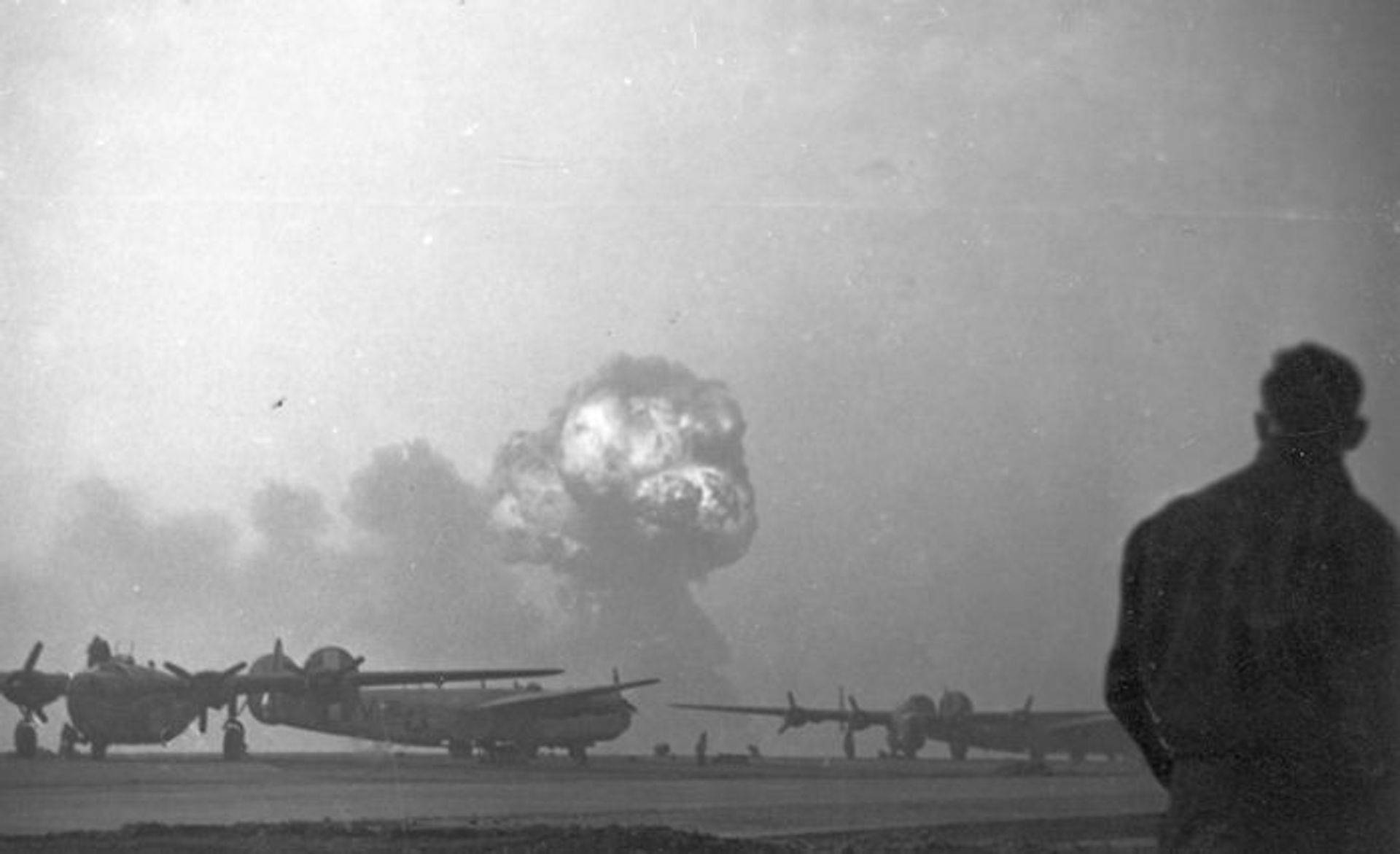
MISSION #21
DATE: March 14, 1945 (Wednesday)
SHIP: 669-J
TARGET: Holzwickede, Germany (M/Y)
G.L. 2700 gallons
B.L. 1100 lbs. TYPE: 10-100 lb. G.P., 1-100 lb. Smoke Bombs
TIME: 0720 hours
DEPUTY LEAD: 1st Squadron
COMMAND PILOT: Capt. Black
After being alerted 5 straight days, we were awakened at 0639, with briefing at 0745. Here we saw our target to be Holzwickede, a small M/Y 10 miles SE of Dortmund. Leissen was to be our secondary. It was a maximum effort, and it was supposed to be a rough one as it was to be visual. Flak guns from Dortmund were 55 at extreme range. Bombing altitude was 22,500 feet with minus 31 degrees Celsius temperature. Take off was 1100, coast in at 1313 with bombs away at 1532, and FTA at 1747. We went to our ship and pre-flighted and were waiting for T.O. when a bomb went off. We noticed a small fire, and soon after a 753rd ship exploded [above], sending flame and debris up to 1000 feet. It resulted in grounding the later squadrons, as they only had one ship operational. The careless Yank is up for court martial. Take off, assembly and D.A.L. went off OK and we hit the Rhine south of Remagen, 13 minutes. G-H went out, and bombs away were late. Flak was accurate and a ______ was hit. I saw all the fighting and that famous bridge. A few ships had to land for gas, and Moran made a wonderful landing. Lt. Col. Hogg commended him. 9 to go.
Intelligence Reports – Marshaling yard. 21 A/C. Haze completely obscured ground. Gee fix placed bombs vicinity of Kamen, solid undercast. No enemy A/C, meager, inaccurate flak. Tracking flak encountered just after bombs away. Haze extremely thick in target area. A/C #206S left formation, vicinity of target after losing #3 engine. Last seen under control heading for France. A/C #567G, 366H and 199A received permission to land on Continent for gas. While on bomb run, tracking blip in all lead A/C went out.
MISSION #22
DATE: March 17, 1945 (Saturday)
SHIP: 669-J
TARGET: Hanover, Germany (Tank Factory)
G.L. 2500 gallons
B.L. 3100 lbs. TYPE: 6-500 lb. G.P., 1-100 lb. Smoke Marker
TIME: 0605 hours
DEPUTY LEAD: 1st Squadron
COMMAND PILOT: Maj. Hensler
We were awakened this morning at 0630 and briefing was at 0730. The target was a tank factory at Hanover and it was to be P.F.F. with 8 to 10/10 [cloud cover]. Flak guns were 270 and it was supposed to be rough. Take off was at 1100, target at 1403, with E.T.A. 1637. We were to fly deputy wing. Temperature was minus 35 degrees Celsius. I was a “little nervous”.
T.O., assembly and route were uneventful. We started our climb at 1239 and Lt. Col. Williamson got on up until 24,500 feet, 2000 feet above briefed. We hit the coast at 1304 and put on our flak suits. We cut the I.P. short and as a few bursts of 88’s came up, we had “bombs away”. It surprised me so much at the little amount of flak that I didn’t know we dropped the bombs. Jerry is very short of ammo, and when it is 10/10’s, he doesn’t throw much up, which is really fine. The trip back was off course, and we didn’t let down until the coast. I rode the tail from R.P. [Rally Point] to base. Only 8 more to go.
Intelligence Reports – Airfield at Kitzingen, near Werzburg. 28 A/C, excellent results. No flak at target, meager and inaccurate encountered en route. Single and twin engine enemy A/C were reported parked on airfield at Wertheim. Two large, two or fourengined, aircraft and two single engine planes were parked at Illesheim airfield.
MISSION #23
DATE: March 20, 1945 (Tuesday)
SHIP: 743-F
TARGET: Hemmingstedt, Germany (Oil Refinery)
G.L. 2600 gallons
B.L. 3100 lbs. TYPE: 6-500 lb. G.P., 1-100 lb. Smoke Marker
TIME: 0500 hours
DEPUTY LEAD: 1st Squadron
COMMAND PILOT: Maj. Betzold
We were awakened very late at 1010 and thought for sure we weren’t going, as our only chance was if it was to be P.F.F. and only one squadron at that. After eating, we were told briefing was 1145. As there was only one squadron going, the briefing room was near empty. We found our target to be an oil refinery just south of Denmark and our trip was to be all over the North Sea. Our secondary was Helgoland, that tiny island. There were 4 guns at the primary and 24 at the secondary. T.O. was 1350, altitude was 20,000 and it was minus 29 degrees Celsius. Each group would comprise a squadron.
We took off in ship #628 and after losing much gas, we had to abort and come back to ship #743. We assembled at the D.A.L. and after a few hours, we hit our I.P. just to the right of Helgoland. Our target was a mass of smoke and flame as we turned after bombs away at 1503. On the way back, one squadron hit Helgoland and one B-24 and one P-51 went down by direct hits. They missed the target by 2 miles as the lead ship “had it”. We landed at 1850 and all in all it was an easy one. Only 7 to go.
Intelligence Reports – Oil refinery, poor results. 10 A/C bombed, the others did not drop because of very heavy haze. No flak, no enemy A/C. Two subs seen surfaced in middle of North Sea. One B-24 from another Group was seen to be shot down by flak at Helgoland while making a turn on that target.
MISSION #24
DATE: March 23, 1945 (Friday)
SHIP: 669-J
TARGET: Osnabruck, Germany (M/Y)
G.L. 2500 gallons
B.L. 3100 lbs. TYPE: 6-500 lb. G.P., 1-100 lb. Smoke Marker
TIME: 0520 hours
DEPUTY LEAD: 1st Squadron
COMMAND PILOT: Capt. Breckenridge
We were awakened at 0330 and briefing was 0445. Here we found our target to be the M/Y at Osnabruck with 2500 gallons and 6-500 G.P.’s as we were D.L. on the wing. It was to be visual with 83 guns and all of us who had been to Osnabruck were really sweating. Take off was 0735, coast in by the Zuider Zee at 0940, I.P. at 1052 and coast out at 1154, with a F.T.R. of 1230. Bombing altitude was 21,000 and D-2 was supposedly 2-1/2 hours.
T.O. and assembly was uneventful and there wasn’t a cloud in the sky. We were late at the coast, but made it up before the I.P. Half-way down the bomb run, the flak really started to come up. Just before “bombs away”, we got hit many times, with a big piece leaving a hole 2-1/2″ in diameter, a foot from the waist window, and others close by. The lead ship got hit and we had to take over at the I.P. when flak came up again, accurate and intense. We hit all the M.P.I.’s and lead the wing back very satisfactorily. All in all, it was a very rough mission, and I thought for sure
I would spend the night in Stalag Luft – 6 to go. (We had 15 holes in the ship.)
Intelligence Reports – Marshaling yard, 27 A/C, pinpoint bombing, fine job. No enemy A/C. Moderate intense, accurate flak, tracking variety encountered en route. Large bursts were reported in ratio of approximately one large to each of four 88mm. Very effective smoke screen at Bremen.
MISSION #25
DATE: March 24, 1945 (Saturday)
SHIP: 910-O
TARGET: Kirtorf, Germany (A/F)
G.L. 2300 gallons
B.L. 1100 lbs. TYPE: 52-100 lb. G.P., 1-100 lb. Smoke Marker
TIME: 0615 hours
LEAD: 3rd Squadron
COMMAND PILOT: Maj. Woodward
Today was a big day. We were restricted last night, and knew that the Rhine was to be crossed. We were to fly the afternoon mission and were awakened at 0845, told to eat, and briefing was to be at 1045. Here we found our target to be Kirtorf A/F with 10 flak guns. It was a job to end the German Air Force strength at the crossing. Take off was 1345, with 52-100 lb. G.P., at 20,000 feet and minus 26 degrees Celsius with CAVU weather. We were to lead the 3rd squadron with our C.P. Maj. Woodward.
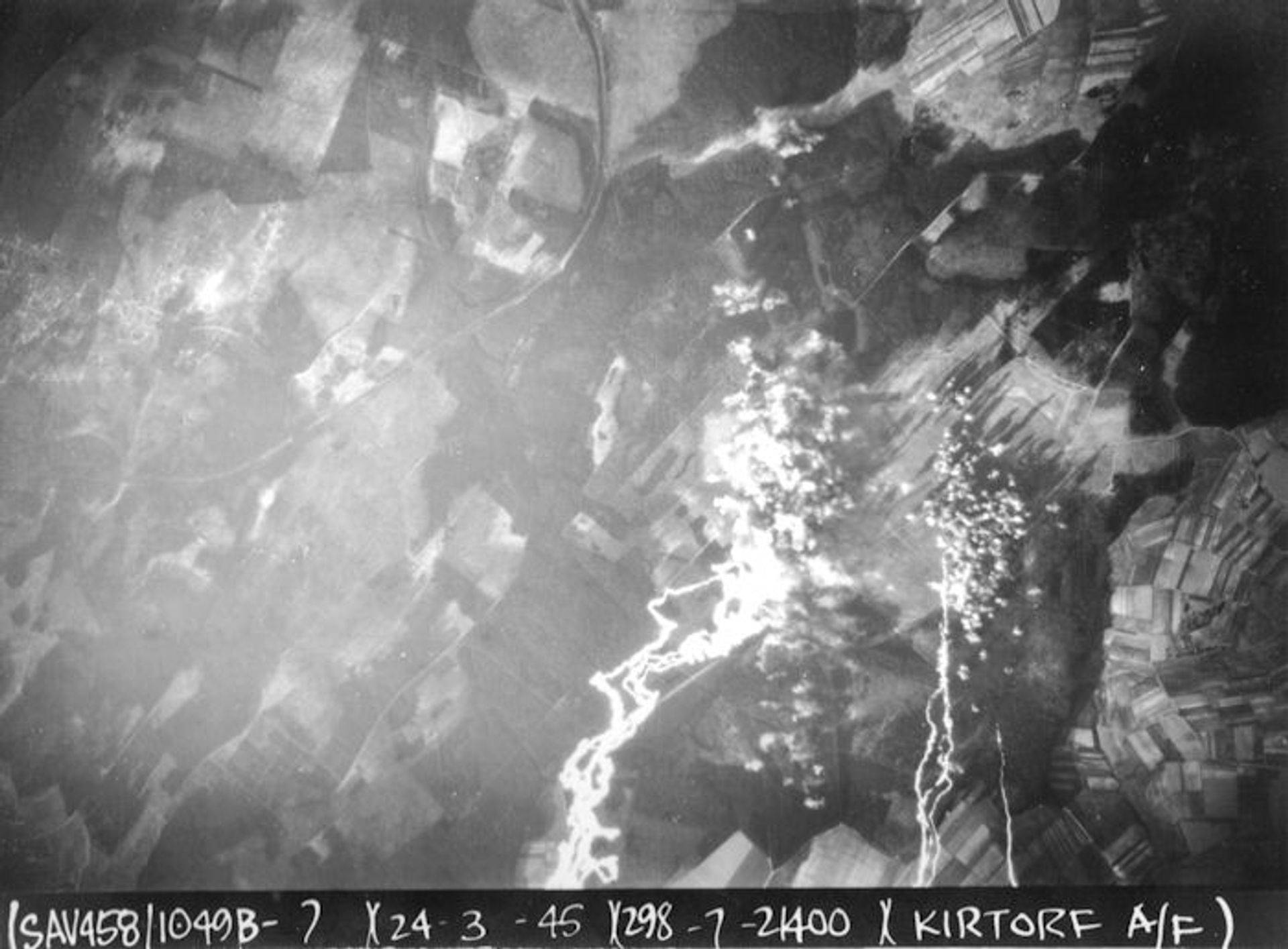
T.O. and assembly was OK, with hundreds of R.A.F. ships coming back. We took off from England and saw a sinking ship in the channel. We crossed the Rhine, south of Coblenz, as the artillery opened up with the 88’s. We hit our I.P. and target OK at 1715. We hit the target and started back. It was getting dark as we crossed the Channel, seeing four more ships sinking. Jerry subs had a field day. Spits and Mosquito’s were all over England as we landed after dark. All in all, it was an easy mission, as the 8th A.F. flew 10,000 sorties. The biggest day yet. 5 to go.
Intelligence Reports – Two missions for today. First, 19 A/C bombed an airfield at Nordhorn in the morning with excellent results. In the afternoon, 18 A/C hit the airfield at Kirtorf with good to excellent results while 9 hit an airfield at Rorshain and one still another field at Hormede with another Group – results were also good. No enemy A/C or flak, first sortie. V-2 contrail seen, appeared to be about 30 miles east. Many fires seen in small towns along the route from I.P. to target. Second sortie, no enemy A/C or flak.
MISSION #26
DATE: April 5, 1945 (Thursday)
SHIP: 557-H
TARGET: Hof, Germany (M/Y)
G.L. 2700 gallons
B.L. 3100 lbs. TYPE: 6-500 lb. G.P, 1-100 lb. Smoke Marker
TIME: 0830 hours
LEAD: 4th Squadron
COMMAND PILOT: Capt. Gardner
After too long of a lay-off, we were told briefing was 0340, they didn’t have to wake us as I hadn’t gone to sleep as yet. We found our target to be Hof M/Y, with a secondary at Plauen. The Hof M/Y had no guns reported, although the Nazi’s had moved all the Government to Berlin, and Plauen had 6-10 . Bombing altitude was to be 18,500 feet or 12,000 minimum. We were to lead the 4th section which was the lead squadron of a 466th/467th formation. We were to form for the first time over France due to weather.
T.O. was OK and we climbed through mist and rain to the beacon, where we found the same sort of weather and after unsuccessfully forming the wing, we took off in no or little formation, picking ships up all along the way. We bombed the Hof M/Y through 10/10 with no flak, although jets were around. No attack. Due to weather, we had to hit the deck at Fulda and came back through the worst weather I’ve ever flown in. We saw all of the destruction of the 3rd Army. 4 to go.
Intelligence Reports – Marshaling yard, 25 A/C. 24 attacked, very poor weather, all PFF. No enemy A/C or flak, to or from target. Weather conditions and poor radio reception made assembly difficult, resulting in 5 A/C bombing with another Group and 13 A/C abandoning mission.
MISSION #27
DATE: April 11, 1945 (Wednesday)
SHIP: 936-I
TARGET: Regensburg, Germany (Oil Storage)
G.L. 2700 gallons
B.L. 2100 lbs. TYPE: 2-1000 lb. G.P., 1-100 lb. Smoke Marker
TIME: 0815 hours
DEPUTY LEAD: 1st Squadron
COMMAND PILOT: Maj LaVelle
We slept late until 0430 with briefing at 0630. We saw a long course to Regensburg when the curtain was raised, which took us to Czechoslovakia. Regensburg has a bad reputation, too. We were to hit an oil storage depot if it was CAVU and a M/Y if otherwise. There were 48 guns at the target. We were deputy wing in a good ship.
T.O. was on time at 0900 with formation over Belgium, which went very good, and we headed out at 5000 feet until crossing the Rhine at Coblenz, where we started our climb. We reached 22,000 feet on course and were somewhat anxious as we had no fighter support. We reached the I.P. and had a long bomb run and dropped at 1311 on the M.P.I. The pall of smoke rose to 1000 feet, immediately followed by a 5000 foot flame. When 50 miles from the target, we could see the smoke at 20,000 feet. Flak was accurate, moderate in the 2nd and 3rd squadron. We saw no holes. I’m too anxious to finish up to add more to these notes. Just 3 to go. What a day…if it comes.
Intelligence Reports – 27 A/C, oil refinery. Good to excellent results. No enemy A/C, moderate, inaccurate flak over target.
MISSION #28
DATE: April 15, 1945 (Sunday)
SHIP: [693-P]
TARGET: Vaux, France (Troop Conc.)
G.L. 2700 gallons
B.L. 3200 lbs. TYPE: 6-85 gallon “Napalm”, 2-100 lb. Smoke Markers
TIME: 0830 hours
LEAD: 2nd Squadron
COMMAND PILOT: Lt. Meyers
Today was going to be a rough mission as we knew we were carrying the new “Fire Bomb”. Briefing was at 0340 and we saw our target to be the German “pocket” of Bordeaux with 122,000 Jerries. We are to lead the 2nd squadron into the target where 27 guns were reported. We went out to the ship and pre-flighted it, finding one bomb leaking badly, but we could do nothing about it. We carried no guns or ammo, so gunners didn’t go.

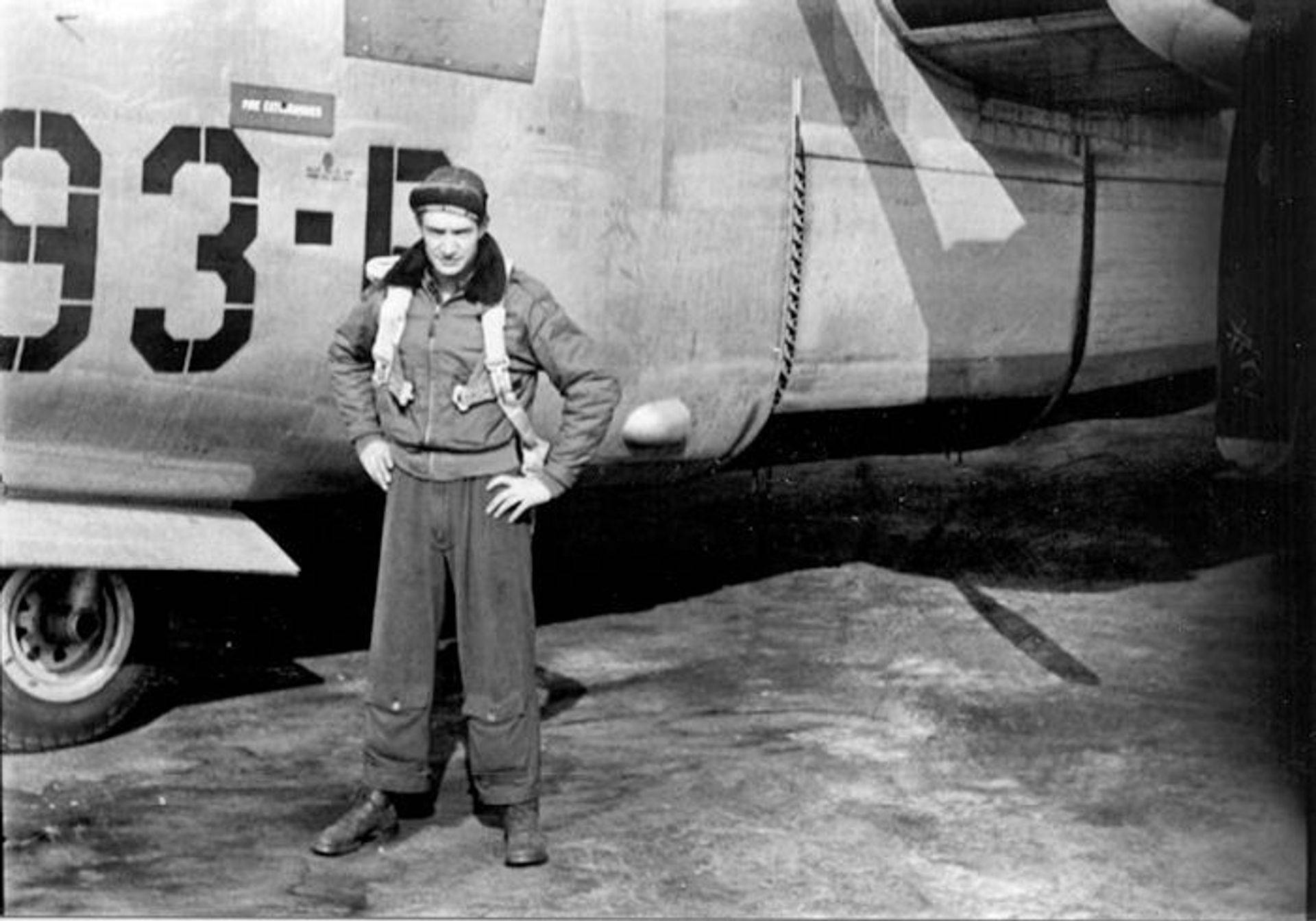
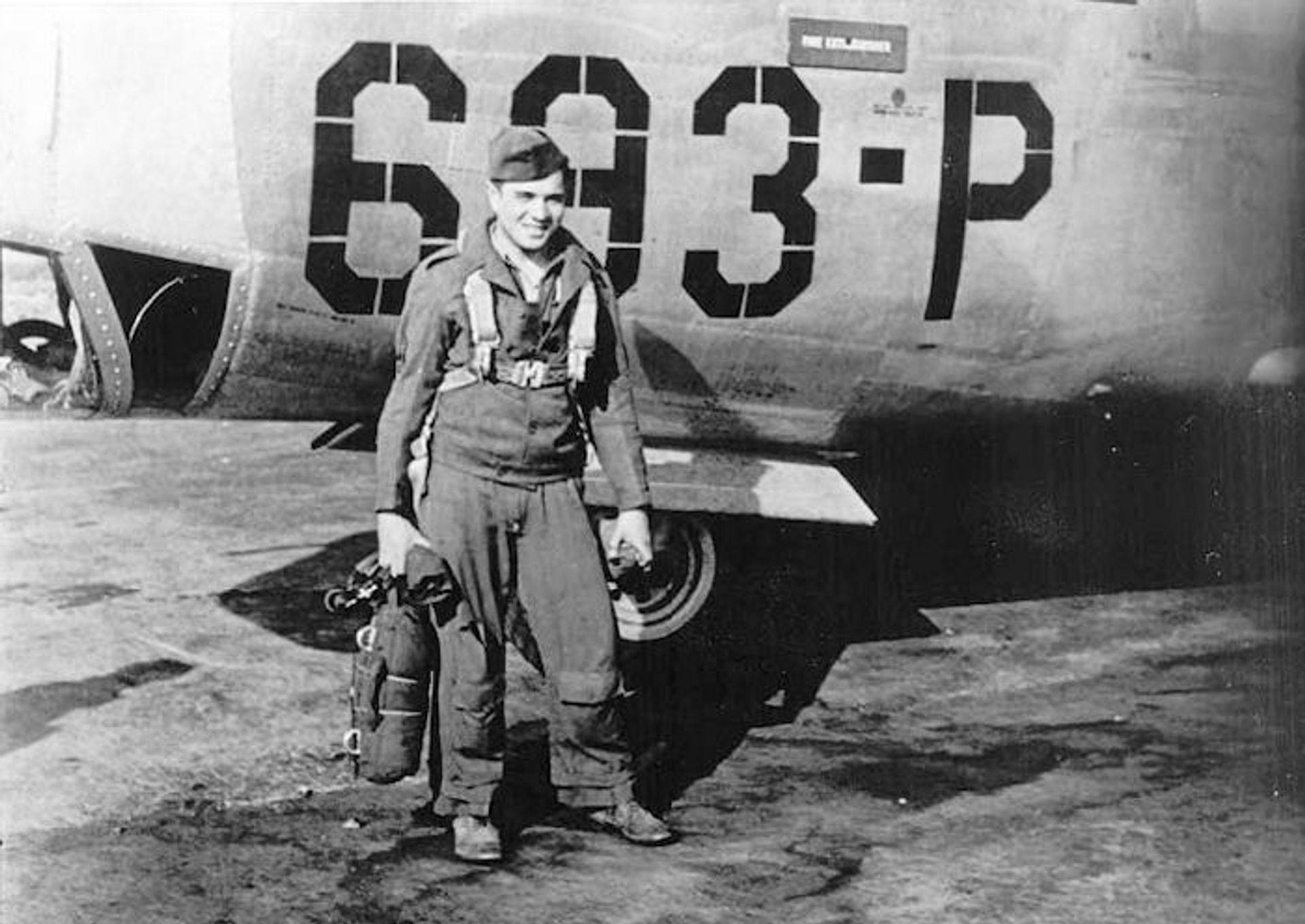
April 15, 1945: John Moran, Clifford VanNess, Ted Urbano
T.O. was at 0610 and assembly over Belgium went off OK and we look off on course, using 100% oxygen due to the gas fumes. We climbed to 15,000 feet to bomb at 1109, and we took out the right waist window and opened up the escape hatch in order to take K-20 pictures. “Bombs Away” was at 1112 and the “bombs” went away like eggs as they had no fires to guide them. All below was flame and smoke and the 15 pictures were good. Jerry had a “hot” day. Just 2 to go. I went as an observer in the waist section of the aircraft .
Intelligence Reports – Same area as yesterday to finish job. First use of napalm, in 75/85 gallon tanks. 27 A/C, results unobserved. No enemy A/C or flak. One A/C #298-E left formation after bombs away and headed inland. His #4 engine was feathered, has not reported.
Back from a mission – 1945
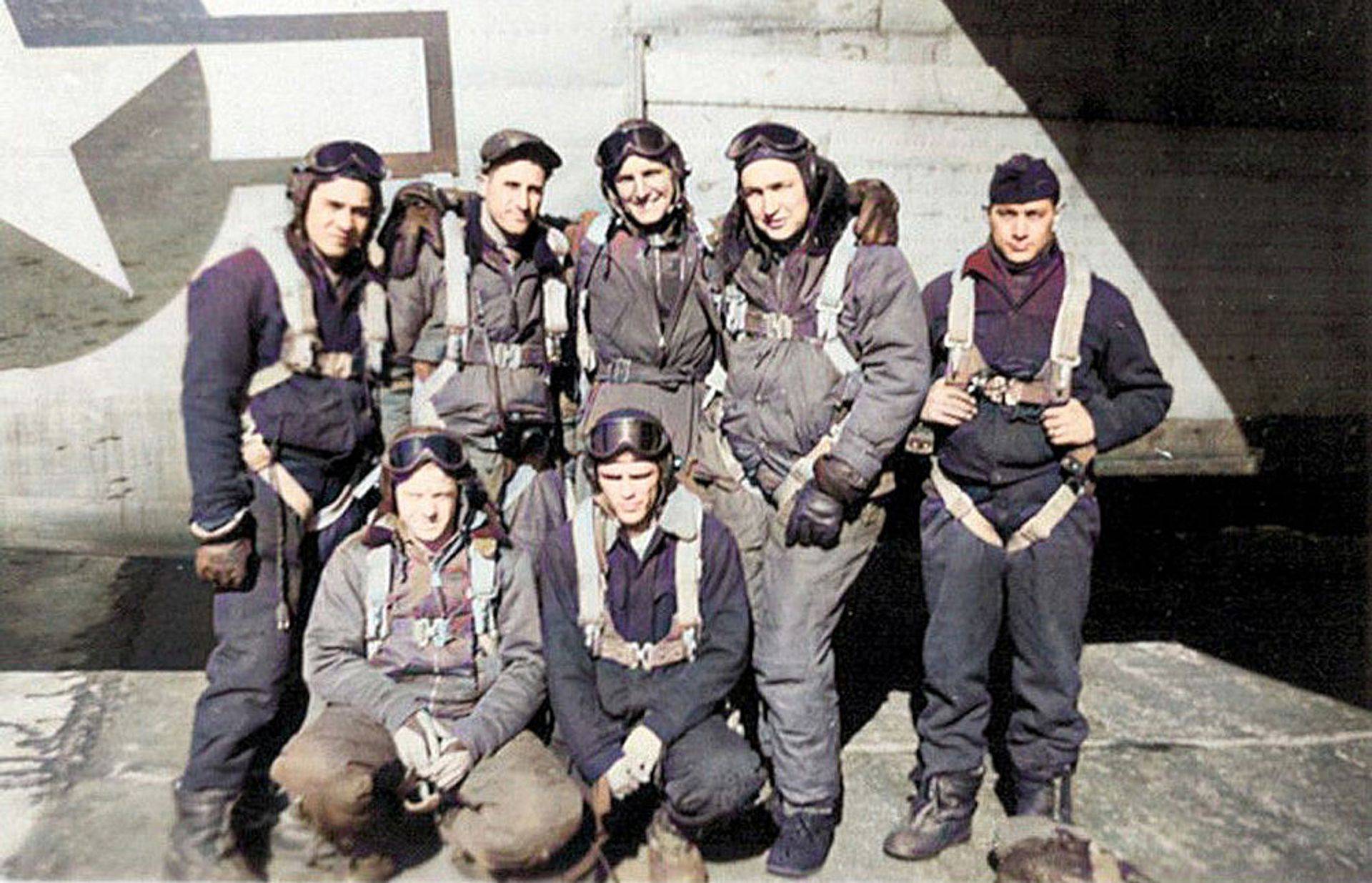
Lt Henry Fraysier

Correspondence between Henry Fraysier, Frank Adams and Lee Watson, July 2005:
Dear Frank,
I have received the latest copy of the 2ADA Journal and was surprised to see Maurice Lee Watson’s story of our crew experience of January 16, 1945. For some reason, the fact that I was Lt. Henry Fraysier, 0712094 Radar Navigator on that flight with Lt. John Moran, pilot, was credited to an enlisted fellow by the name of Alden Armstrong. There are a lot of details that I was not remembering and most likely never was told. I knew that we had several extra men on board that day. Since my Radar set was destroyed over the target, I had nothing in the way of standard charts to see except I remember that you and I examined yours and was not able to identify the area below. At that time I was told to face the open bomb bay doors and be ready to be the first one out with the people in the back area to follow me down. I also remember that you fell on a rock pile and broke an ankle and Moran bounced off a farm building roof before hitting the ground.
You may remember that I found a farm family who took me in for the evening meal and bedded me down on the kitchen cobblestone floor to sleep that night. They sent me to school with the children to talk with their teacher the next morning and she directed me in the right direction to get back with the rest of you. That’s when the FFI came down to check me out and after examining my headphones, knew I was an American.
Dear Lee,
I noticed that the village of Ferrierres is only about 55 miles from the center of Paris and along a stream that runs southward to the town where I was picked up (St. Sauveur) and that in turn is about 7 miles from Clamecy where Harold Jones was identified. I suppose that he may have been moved to the nearest town so that it was not necessarily where he was found. The locations sort of line up in a strange way but that may be that the plane was no longer traveling in a SW direction after the power was entirely gone. I would have expected that my touch down area would have been lined up closer to the others but I have to remember that I was in the middle of a farmers field and headed towards the nearest tree line and walked some distance before deciding to take my chances at approaching the farm house where I was taken in for the evening and night. Since I had no compass, I don’t really know which way I walked with the children to see their teacher who directed me onward. I had a small amount of French language to fall back on so it was easier for me.
March 12, 2005 – Ferrieres, France
Click image for larger view of monument
The plaque reads:
On January 16,1945, near the hamlet of Ferrieres An American bomber crashed The U.S. Air Force Liberator B 24J – 50954 Heavily damaged by German anti-aircraft fire over Magdeburg The crew managed to bring under control the plane in distress and to return to our liberated country. Low on fuel, the order to evacuate the craft was given while over Fontenailles. Two machine gunners did not survive the landing
THE CREW
Lt. John W. MORAN Pilot and crew chief
Major PHILLIPS – Pilot
Major VACEK – Bombardier
Lt. TRASKIN** – 1st navigator
Lt. Franck A. ADAMS – 2nd navigator
Staff Sergeant ARMSTRONG* – Radar operator
Staff Sergeant Clifford VAN NESS – Radio operator
Staff Sergeant Theodoro URBANO – Flight engineer
Staff Sergeant Maurice L. WATSON – Machine-gunner
Staff Sergeant Richard B. SMITH – Killed in action
Staff Sergeant Harold JONES – Killed in action
Staff Sergeant’s Smith and Jones gave their lives for the defense of our freedom and the fight against Nazism LET US NOT FORGET THEM
* This should be F/O Alden Armstrong, Pilotage Navigator
** Inadvertently omitted from the memorial is Lt Henry Fraysier, Radar Navigator on this mission. I believe his name was mixed up with “Lt Traskin” of which there is no such record.
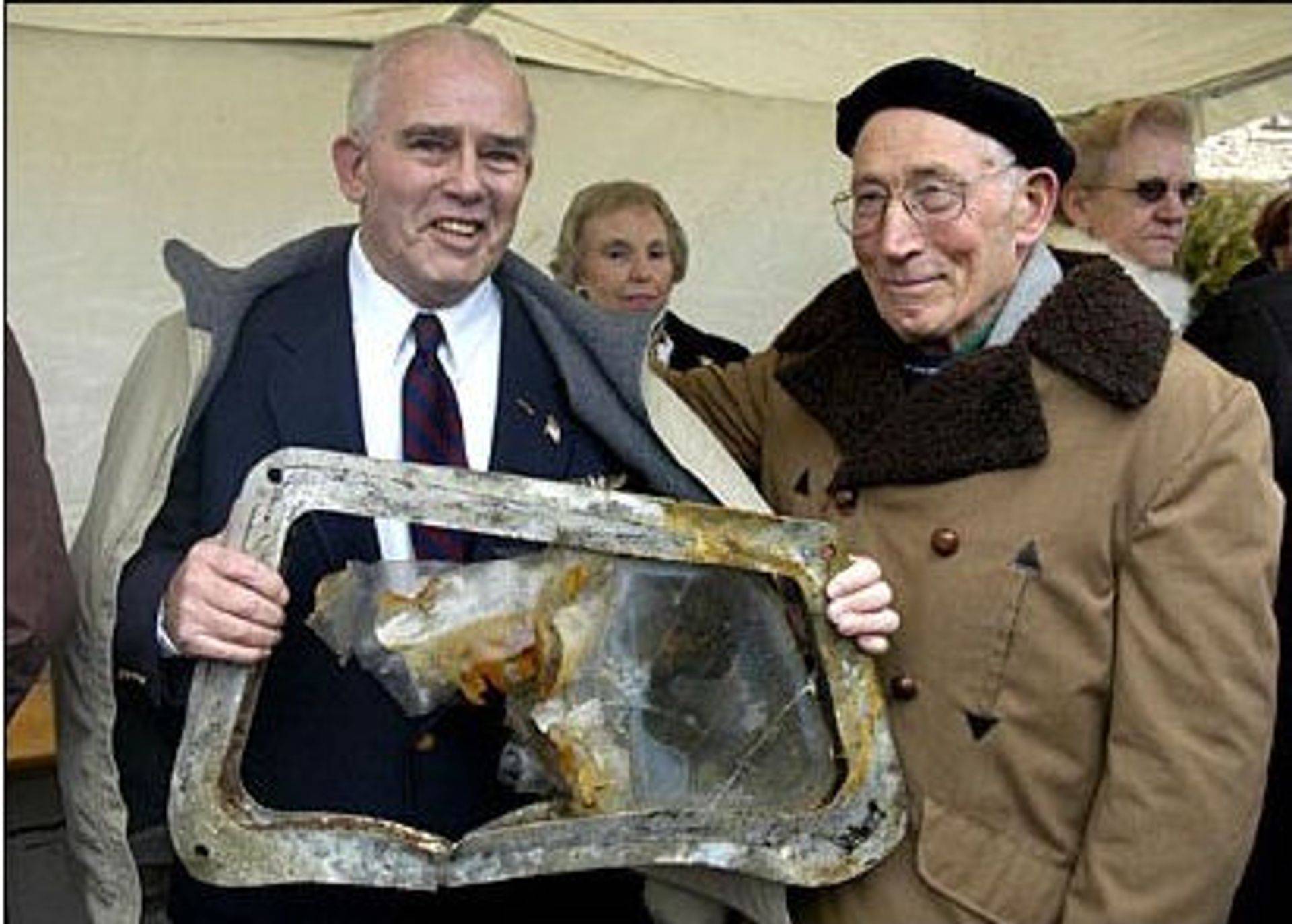
Monsieur Roger Pinion, one of the inhabitants of Ferrieres, presents Maurice Lee Watson with one of the plane’s windows, 60 years after it crashed. Lee promised to take it back to the USA with him.
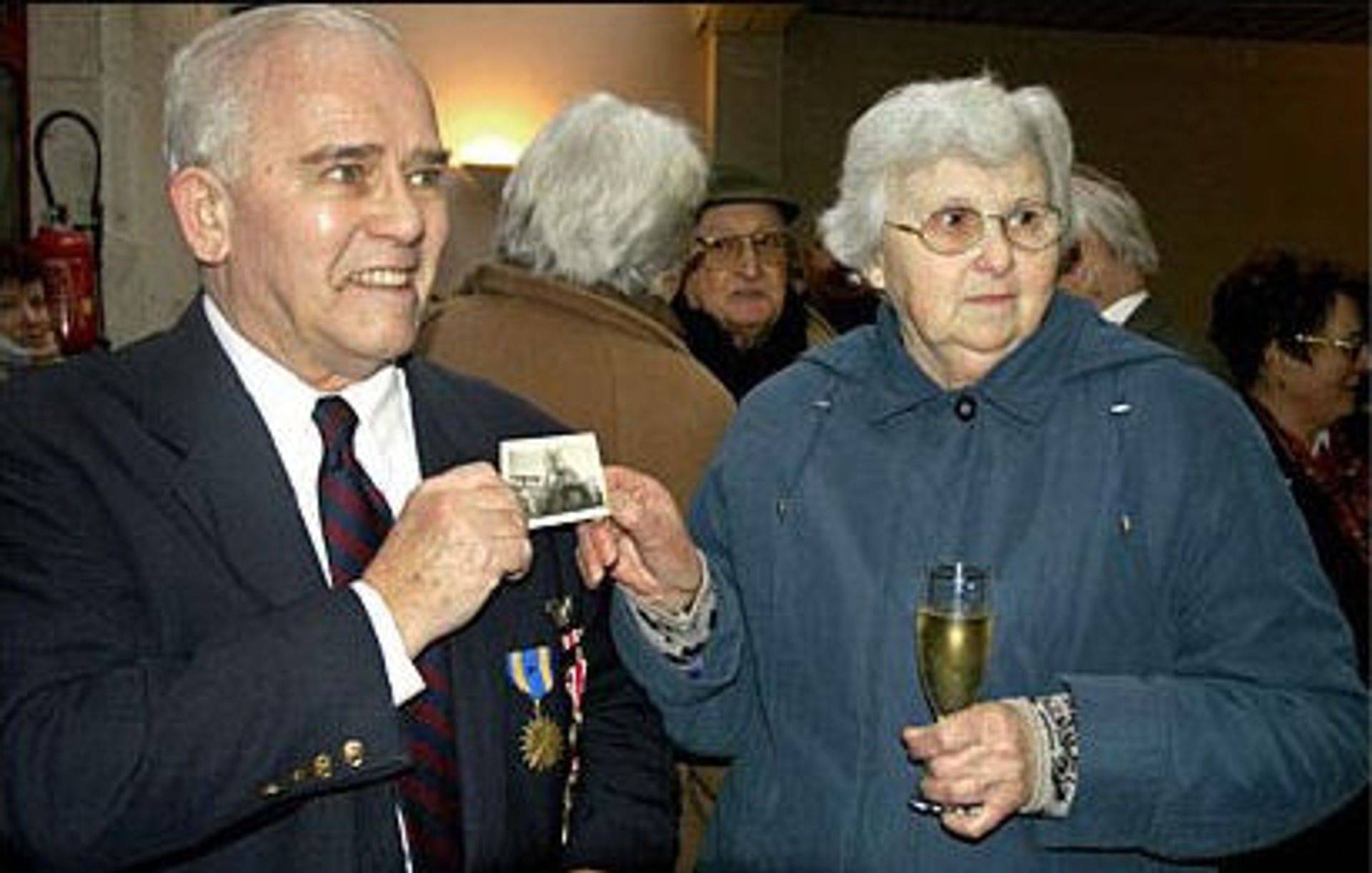
One of the strong moments of this commemoration was the reunion of Maurice Lee Watson with Jacqueline Hytier, the young girl on the left of the photograph (above) that enabled Jacques to retrace the whole story.
Photos: Bernard Delfino
August 2008

Lee Watson at his old position in the Colling’s Foundation Liberator

